Most view
- Page Path
- HOME > Browse Articles > Most view
The most viewed articles in the last three months among those published since 2023.
Research Articles
- [English]
- Understanding the charactersitics and types of single-person households based on food purchase frequencies in Korea: a cross-sectional study using the 2023 Consumer Behavior Survey for Foods
- So-Yun Kim, Youngmin Nam, Jong-Youn Rha, Haerang Lee
- Korean J Community Nutr 2025;30(1):27-39. Published online February 28, 2025
- DOI: https://doi.org/10.5720/kjcn.2025.00031

-
 Abstract
Abstract
 PDF
PDF - Objectives
This study investigated the differences in food purchase frequency among single-person households by gender and age group and explored the characteristics of single-person household groups according to their food purchase patterns.
Methods
Utilizing data from the 2023 Consumer Behavior Survey for Foods conducted by the Korea Rural Economic Institute, this study examined food purchase frequencies among 966 single-person households. Data were analyzed using Rao-Scott chi-square tests, ANCOVA, ANOVA, and K-modes hierarchical cluster analysis.
Results
Significant differences were observed in the food purchase frequencies of single-person households for fresh and convenient food. Women displayed higher purchase frequencies for fish, vegetables, and fruits, whereas men showed higher purchase frequencies for convenient foods (P < 0.005). Single-person households aged 39 years and younger exhibited lower purchase frequencies for vegetables (P < 0.005) and fish (P < 0.001) and substantially higher frequencies of convenient food purchases (P < 0.001). Additionally, this study identified three distinct single-person household groups based on food purchase pattern: the “nutrition-conscious” group, which exhibited high purchase frequency for fresh foods; the “convenience-seeking” group, which showed high purchase frequency for all types of convenient foods; and the “passive food consumer” group, which displayed relatively low purchase frequency for both fresh foods and convenient foods. The socio-demographic characteristics of single-person households differed significantly across these three groups, with the “passive food consumer” group and “convenience-seeking” group exhibiting lower healthy eating competency (MN(nutrition-conscious group) = 3.68, MP(passive-food-consumer group) = 3.40, MC(convenience-seeking group) = 3.52, P < 0.001), safe eating competency (MN = 3.87, MP = 3.57, MC = 3.77, P < 0.001), and satisfaction (MN = 3.36, MP = 3.23, MC = 3.25, P = 0.04) than the “nutrition-conscious” group.
Conclusion
This study underscores the need for targeted nutrition programs to address the unique needs of single-person households depending on their characteristics. Specifically, this study highlights the importance of targeted interventions for “convenience-seeking” and “passive food consumer” to promote dietary competency and encourage healthy dietary behavior. -
Citations
Citations to this article as recorded by- Secular trends in dietary patterns among Korean adults: using data from the 2007–2022 Korea National health and nutrition examination survey
Eunyoung Tak, Juhae Kim, Heejin Lee, Minji Kang
Nutrition Journal.2025;[Epub] CrossRef
- Secular trends in dietary patterns among Korean adults: using data from the 2007–2022 Korea National health and nutrition examination survey
- 8,734 View
- 76 Download
- 1 Crossref

- [English]
- Total sugar intake and its contributed foods by age groups in Koreans using the 8th (2019–2021) Korea National Health and Nutrition Examination Survey: a cross-sectional study
- Hyejin Yu, Sang-Jin Chung
- Korean J Community Nutr 2024;29(3):222-233. Published online June 30, 2024
- DOI: https://doi.org/10.5720/kjcn.2024.29.3.222

-
 Abstract
Abstract
 PDF
PDF - Objectives
This study was conducted to investigate the status of total sugar intake and contributing foods in Korea according to age groups.
Methods
This study used 24-hour dietary recall data from the 8th Korea National Health and Nutrition Examination Survey (2019–2021) to investigate the nutritional and total sugar intake status among Koreans. A total of 18,338 research participants (≥3 years old) were included in this study. To analyze the types of foods contributing to total sugar intake, these foods were categorized into 15 types. Moreover, we examined the total sugar intake and ranked the most consumed foods by age groups (3–11 years, 12–18 years, 19–34 years, 35–49 years, 50–64 years, over 65 years). A survey procedure was employed for statistical analysis.
Results
The energy intake ratio from total sugars was approximately 12%–15%, which was within the recommended range. However, the proportion of individuals consuming total sugar exceeding 20% of their total caloric intake is nearly 20%, raising concerns about excessive sugar consumption. Furthermore, the percentage of participants whose intake of sugar from processed foods exceeded 10% of their total calories was highest in the 12–18 age group at 37.1%, followed by the 3–11 age group at 35.2%, and the 19–34 age group at 34.0%. Carbonated drinks, cola, and cider were the primary foods consumed by children and adolescents (3–18 years old) and young adults (19–34 years old). For middle-aged and older adults, mixed coffee with sugar and cream was a prominent contributor to sugar intake.
Conclusions
This study investigated sugar consumption patterns among Koreans, finding the principal foods contributing to this intake. Identifying these contributors is pivotal, given their potential impact on public health.
- 10,592 View
- 138 Download

- [English]
- Regional differences in protein intake and protein sources of Korean older adults and their association with metabolic syndrome using the 2016–2019 Korea National Health and Nutrition Examination Surveys: a cross-sectional study
- You-Sin Lee, Yoonna Lee
- Korean J Community Nutr 2024;29(3):173-188. Published online June 30, 2024
- DOI: https://doi.org/10.5720/kjcn.2024.29.3.173
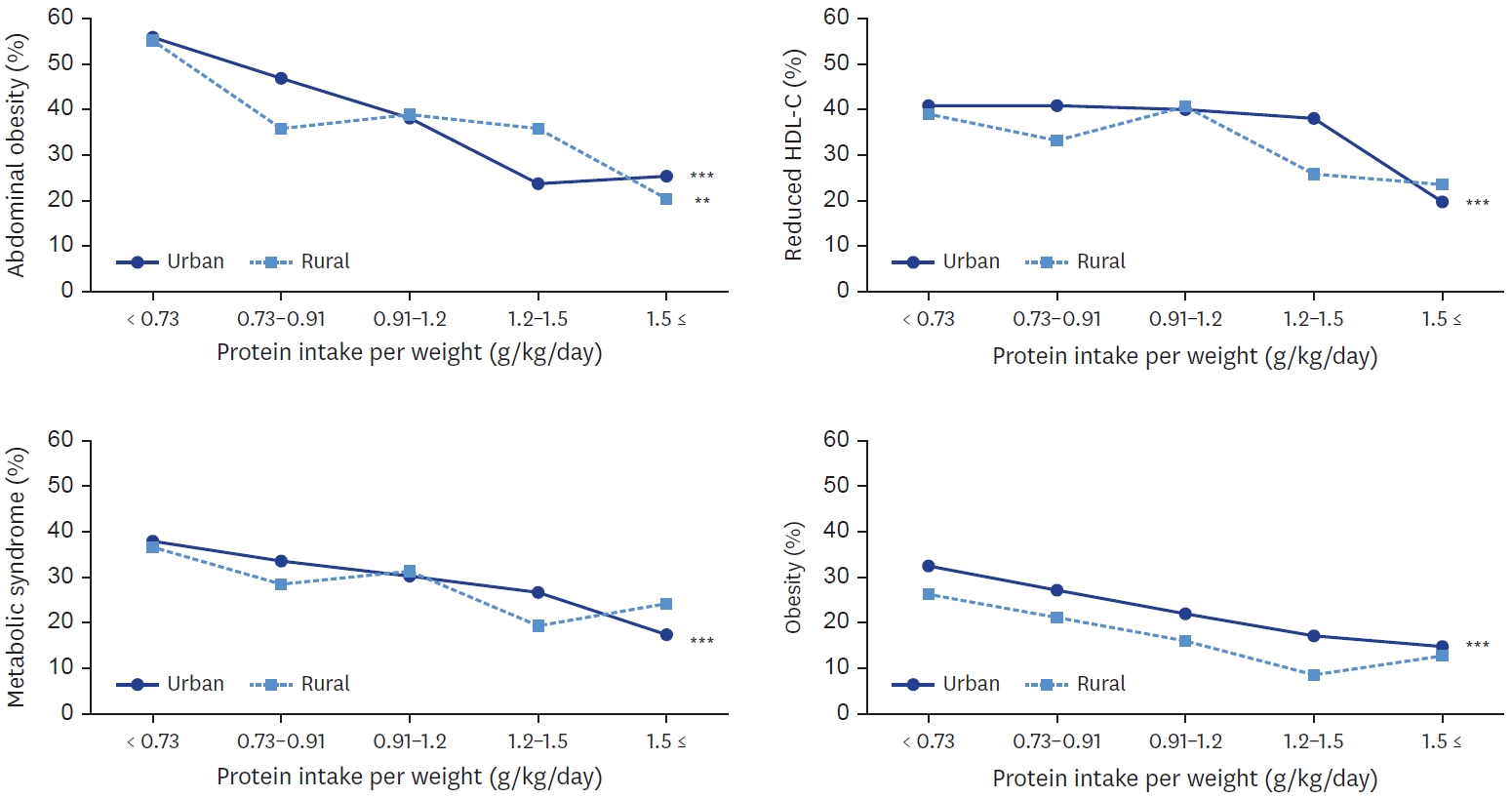
-
 Abstract
Abstract
 PDF
PDF - Objectives
The study aim was to analyze the regional differences in dietary protein intake and protein sources of Korean older adults and their association with metabolic syndrome.
Methods
Study participants were 1,721 older adults aged 65 and over who participated in 2016–2019 Korea National Health and Nutrition Examination Survey. Using 24-hour recall dietary intake data, protein intake and their food sources were examined. The association between protein intake and metabolic syndrome, obesity, and abdominal obesity were analyzed by multiple logistic regression.
Results
Total protein and animal protein intakes were higher in urban area (60.0 g, 24.4 g, respectively) than in rural area (54.6 g, 19.6 g, respectively). With increase of protein intake level, animal to total protein proportion was increased in both areas. Total protein and plant protein intake was negatively associated with the risk of obesity, abdominal obesity in both areas. Animal protein intake was negatively associated with the risk of obesity in both areas, and with abdominal obesity only in urban area. In urban area, plant protein intake was also negatively associated with the risks of metabolic syndrome, elevated triglyceride, and reduced high density lipoprotein-cholesterol. In urban area, the risk of metabolic syndrome was decreased when their protein intake was more than 0.91 g/kg and was lowest when their protein intake was more than 1.5 g/kg (P for trend < 0.001).
Conclusions
Korean older adults showed inadequate protein intake and those in rural area showed lower animal protein intake than in urban area. The risk of obesity and metabolic syndrome was decreased with the increase of protein intake level. These findings may help develop effective nutrition support strategy for older adults to reduce regional health disparity.
- 8,535 View
- 100 Download

- [English]
- Food and nutrient intake in pregnant women with singletons or multiples and post-delivery changes in intake in Korea: an observational study
- Cheawon Lee, Dahyeon Kim, Yoon Ha Kim, Myeong Gyun Choi, Jong Woon Kim, Clara Yongjoo Park
- Korean J Community Nutr 2025;30(1):1-15. Published online February 28, 2025
- DOI: https://doi.org/10.5720/kjcn.2024.00325
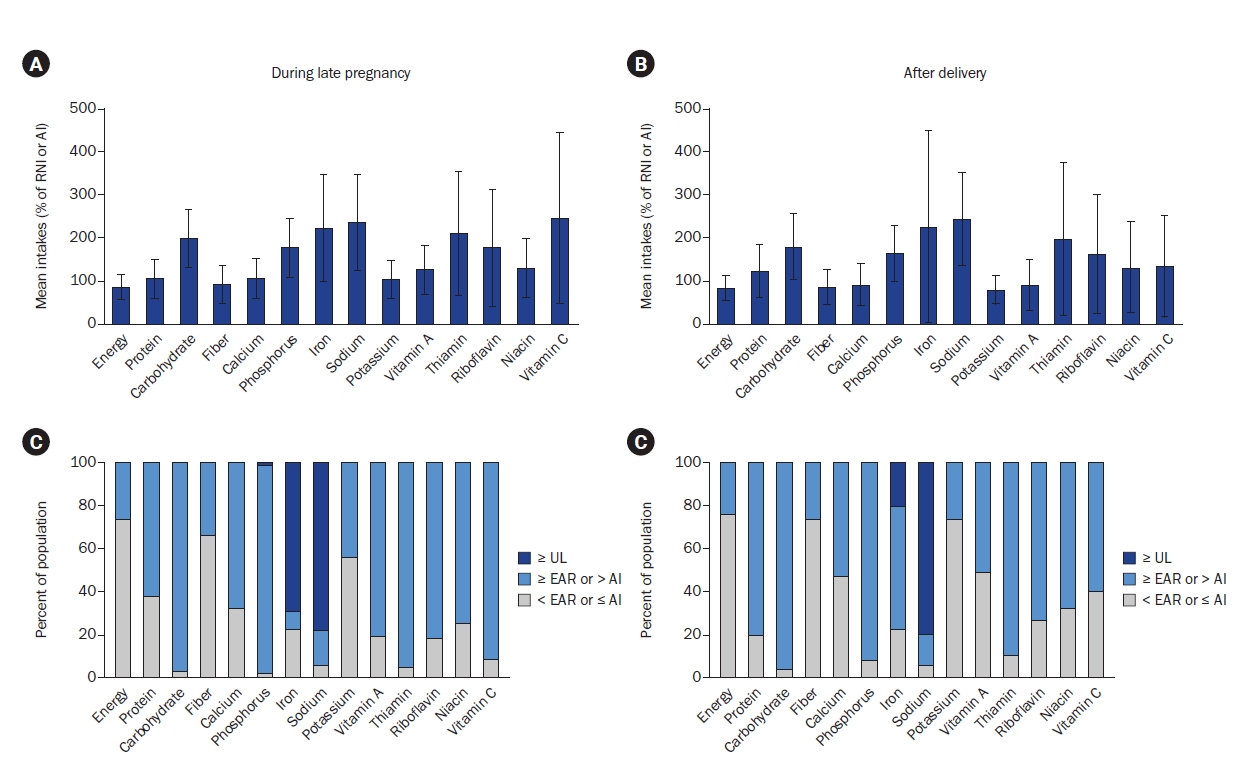
-
 Abstract
Abstract
 PDF
PDF Supplementary Material
Supplementary Material - Objectives
Nutrient intake during pregnancy and lactation is crucial for the health of both mother and offspring. Diet and nutrient metabolism potentially vary according to ethnicity and fetal number; nevertheless, recent studies validating this are inadequate. Furthermore, few studies have tracked changes in intake after delivery. We compared the food and nutrient intakes between pregnant women in Korea carrying singletons and multiples during late pregnancy and assessed their changes through postpartum.
Methods
Ninety-eight pregnant women were recruited from Chonnam National University Hospital between January 2019 and December 2023, and 48 responded to follow-up. Third trimester and postpartum intake were assessed via food frequency questionnaires and supplement questionnaires. Student’s t-test, Mann–Whitney U test, chi-square test, paired t-test or Wilcoxon signed-rank test was performed and adjustments were made for covariates.
Results
Nutrient intake was generally adequate relative to the Dietary Reference Intakes for Koreans, with no differences between singleton- and multiple-pregnancy women. Sixty-six of 98 (67%) pregnant women consumed meat, fish, vegetables, and fruit daily. Dairy intake was low, while the mean iron intake during pregnancy reached 54.2 ± 34.0 mg/d, exceeding the tolerable upper intake level, mainly owing to supplements. Postpartum fruit and vitamin C intake decreased, with no significant differences between breastfeeding and non-breastfeeding women.
Conclusion
Dietary intake did not significantly differ between Korean singleton- and multiple-pregnancy women. Dairy intake was low and iron intake was excessive. Fruit intake decreased after delivery; however, difference in dietary intake according to breastfeeding status was minimal. Nutritional education may be necessary to promote a balanced diet in pregnant and postpartum women. Trial Registration: Clinical Research Information Service Identifier KCT0005118. -
Citations
Citations to this article as recorded by- Placental cadmium and its association with maternal diet and offspring growth in Koreans
Dahyeon Kim, Cheawon Lee, Yoon Ha Kim, Myeong Gyun Choi, Jong Woon Kim, Clara Yongjoo Park
Nutrition Research and Practice.2025; 19(3): 473. CrossRef
- Placental cadmium and its association with maternal diet and offspring growth in Koreans
- 5,642 View
- 61 Download
- 1 Crossref

- [English]
- Effects of a multi-component program based on partially hydrolyzed guar gum (Sunfiber®) on glycemic control in South Korea: a single-arm, pre-post comparison pilot clinical trial
- Hyoung Su Park, A-Hyun Jeong, Hyejung Hong, Hana Jang, Hye-Jin Kim
- Korean J Community Nutr 2025;30(1):40-52. Published online February 28, 2025
- DOI: https://doi.org/10.5720/kjcn.2024.00276
- Correction in: Korean J Community Nutr 2025;30(2):173
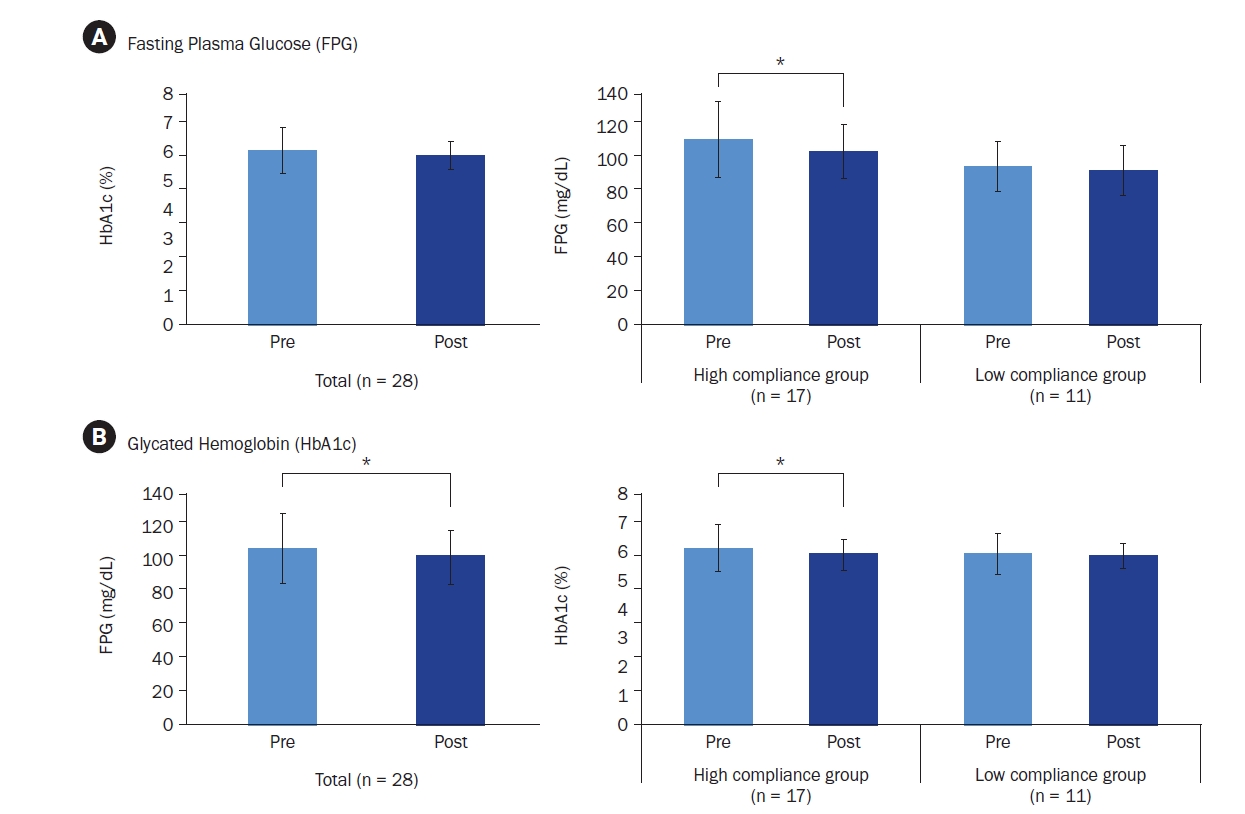
-
 Abstract
Abstract
 PDF
PDF - Objectives
The aim of this study was to assess the impact of a multi-component program, including partially hydrolyzed guar gum (PHGG, Sunfiber®) supplementation, on glycemic control, gut health, and nutritional status to support diabetes prevention and management among Korean adults.
Methods
A single-arm trial was conducted with 29 adults (aged 20-55 years) with fasting plasma glucose (FPG) ≥ 100 mg/dL. Over a six-week period, participants engaged in a multi-component program that incorporated the supplementation of PHGG (Sunfiber®, 12.5 g/day), weekly nutritional coaching, and the use of continuous glucose monitoring devices. The program’s effectiveness was evaluated by measuring FPG and glycated hemoglobin (HbA1c) levels through blood tests conducted before and after the intervention. Improvements in gut health were gauged using the Korean Gut Quotient Measurement Scales, while enhancements in nutritional status were assessed using the Nutrition Quotient (NQ) and surveys that evaluated improvements in gut health and nutritional status.
Results
Participants’ average age was 43.89 years, with approximately 80% being male. Most participants (about 75%) were classified as overweight or obese. After six-weeks, 17 participants who adhered closely to the program (meeting certification criteria) exhibited significant reductions in key blood glucose markers. FPG levels decreased from 113.06 ± 23.16 mg/dL to 106.24 ± 16.33 mg/dL (P < 0.05), and HbA1c levels decreased from 6.08% ± 0.81% to 5.87% ± 0.53% (P < 0.05). The NQ evaluation revealed significant increases in comprehensive nutrition scores, and in the balance and practice domain scores for all participants (P < 0.05). Furthermore, in the gut health survey, approximately 82.1% of all participants reported experiencing positive changes.
Conclusion
Among adults with elevated FPG levels, a multi-component intervention program that included PHGG (Sunfiber®) supplementation, structured dietary management, and the use of health-monitoring devices showed significant benefits in improving glycemic control, overall nutritional status, and gut health. Trial Registration: Clinical Research Information Service Identifier: KCT0010049.
- 6,420 View
- 41 Download

- [English]
- Nutritional content and healthiness in sweet and salty snacks and beverages popular in South Korea and the United States assessed by nutrition labels: a cross-sectional comparative study
- Bo Jeong Gong, Segovia Lucas, Diewo Camara, Pauline E. Jolly, Chandrika Piyathilake, Taisun Hyun
- Korean J Community Nutr 2024;29(6):467-479. Published online December 31, 2024
- DOI: https://doi.org/10.5720/kjcn.2024.00290
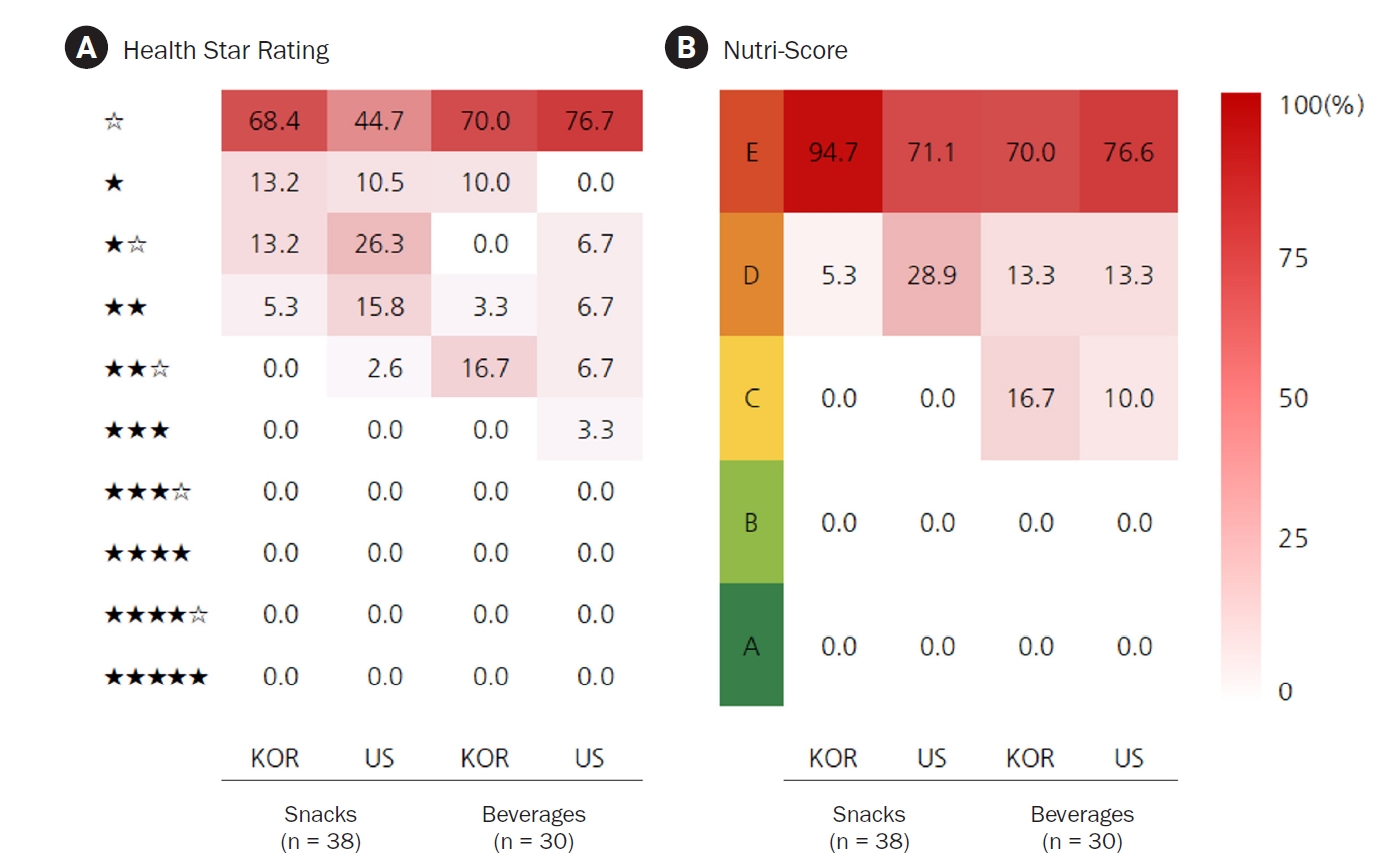
-
 Abstract
Abstract
 PDF
PDF - Objectives
This study investigated the nutritional differences between sweet and salty snacks and beverages in South Korea (Korea) and the United States (US). Nutritional content and healthiness were determined using back- and front-of-package nutrition labeling (FoPNL) systems.
Methods
Three snack and three beverage categories popular in Korea and the US were selected. Statistical data were used to determine the top 10–15 best-selling products in each category in each country. The selected products included chips (n = 15), cookies (n = 10), chocolate (n = 13), carbonated drinks (n = 10), fruit juices/drinks (n = 10, 5/5), and energy drinks (n = 10). The study excluded products that were artificially sweetened. Nutritional information and percentages of fruit and vegetable content in each product were collected from brand websites and grocery stores in each country. The FoPNL system was used to assess the healthiness of the products, which included multiple traffic light labels, a Health Star Rating, and a Nutri-Score.
Results
Overall, Korean snacks contained significantly more protein, total fat, saturated fat, and cholesterol than US snacks. However, the US chips and carbonated drinks contained more sodium, while the US energy drinks contained more caffeine than Korean products. The serving size of US carbonated drinks was significantly larger than that of Korean drinks, whereas the serving size of US chips was smaller than that of Korean products. The FoPNL system classified the majority of products as ‘less healthy.’
Conclusion
Our results suggest that Korean and US food manufacturers should improve the nutritional quality and/or serving size of commonly consumed food products. Policymakers in both countries should work to improve the presentation of ingredient and nutrient information on nutritional labels to assist consumers in making healthier food choices.
- 5,203 View
- 51 Download

- [English]
- Trends in growth and nutritional status of Korean toddlers and preschoolers: a cross-sectional study using 2010–2021 Korea National Health and Nutrition Examination Survey data
- Annisa Turridha, Jae Eun Shim
- Korean J Community Nutr 2024;29(6):480-491. Published online December 31, 2024
- DOI: https://doi.org/10.5720/kjcn.2024.00241
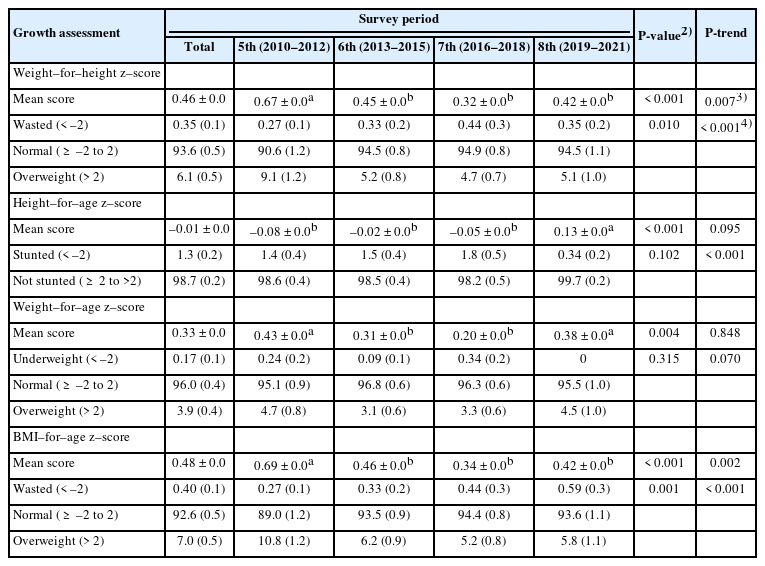
-
 Abstract
Abstract
 PDF
PDF - Objectives
We aimed to analyze trends in growth and nutrient intake patterns in Korean toddlers and preschoolers and generate data for international comparisons of early childhood growth status.
Methods
Overall, 3,661 children aged 1–4 years were included. This study used the data from the 5th–8th Korea National Health and Nutrition Examination Survey. The weight-for-height, height-for-age, weight-for-age, and body mass index-for-age z-scores of the participants were calculated using the World Health Organization 2006 child growth z-score reference cutoff points. The 24-hour recall method was used to determine dietary intake, which was assessed according to the Dietary Reference Intake for Koreans. All statistical analyses were conducted and weighted according to a complex sample design.
Results
Most Korean toddlers and preschoolers demonstrated normal growth, with an increasing trend noted over the survey period. Concurrently, the prevalence of overweight decreased. The mean intake of energy from fat exhibited an upward trend, paralleling that of protein and fat. Conversely, the intake of several essential micronutrients declined. The prevalence of nutritional inadequacy showed significant variation throughout the survey period; the proportion of inadequacy in carbohydrate intake decreased, whereas those of iron, vitamin A, thiamin, niacin, and vitamin C increased.
Conclusion
South Korea is making significant progress in supporting toddlers and preschoolers, as evidenced by consistent increases in the proportion of children with normal growth and decreases in the prevalence of malnutrition. Future research should focus on exploring dietary patterns and analyzing specific food groups that are essential for promoting optimal growth and nutritional status in children.
- 4,277 View
- 56 Download

- [English]
- Screen time, mealtime media use, and dietary behaviors in Korean preschoolers : a cross-sectional study
- Young-Hee Han, Saerom Shin, Eun Yeol Woo, Hye-Kyung Park, Taisun Hyun
- Korean J Community Nutr 2023;28(3):206-219. Published online June 30, 2023
- DOI: https://doi.org/10.5720/kjcn.2023.28.3.206
-
 Abstract
Abstract
 PDF
PDF - Objectives
Screen time refers to the time spent using screen media, such as televisions, smartphones, computers, or tablets. Excessive exposure to screen media has been reported to negatively impact young children’s health and development, including overweight, short sleep duration, and language delays. This study examined the association of screen time and mealtime media use with dietary behaviors among preschool children.
Methods
A cross-sectional survey was conducted on parents of children aged three to five years using the online questionnaires of the Nutrition Quotient for Preschoolers (NQ-P) and the Dietary Screening Test (DST). Data from 261 children’s parents were analyzed.
Results
Of the 261 children, 96.9% used screen media, 55.6% used screen media for two hours or more daily, and 30.7% were exposed to screen media during meals. The NQ-P scores were significantly lower in the children with longer screen time and mealtime media use. Children who used screen media for two hours or more and those exposed to screen media during meals consumed kimchi less frequently and confectionery and sugar-sweetened beverages more frequently than children who used less than two hours and were not exposed to screen media during meals. In addition, they were more likely to be picky about food, refuse to eat, and less likely to feed themselves than children with shorter screen time and no mealtime media use.
Conclusions
This study reported an association between unhealthy dietary behaviors, feeding difficulties, and screen time and mealtime media use among preschool children. Further research should explore effective strategies for reducing children’s screen time.
- 5,023 View
- 86 Download

- [English]
- Factors influencing consumers’ continuance intention in online grocery shopping: a cross-sectional study using application behavior reasoning theory
- Binglin Liu, Min A Lee
- Korean J Community Nutr 2024;29(3):199-211. Published online June 30, 2024
- DOI: https://doi.org/10.5720/kjcn.2024.29.3.199
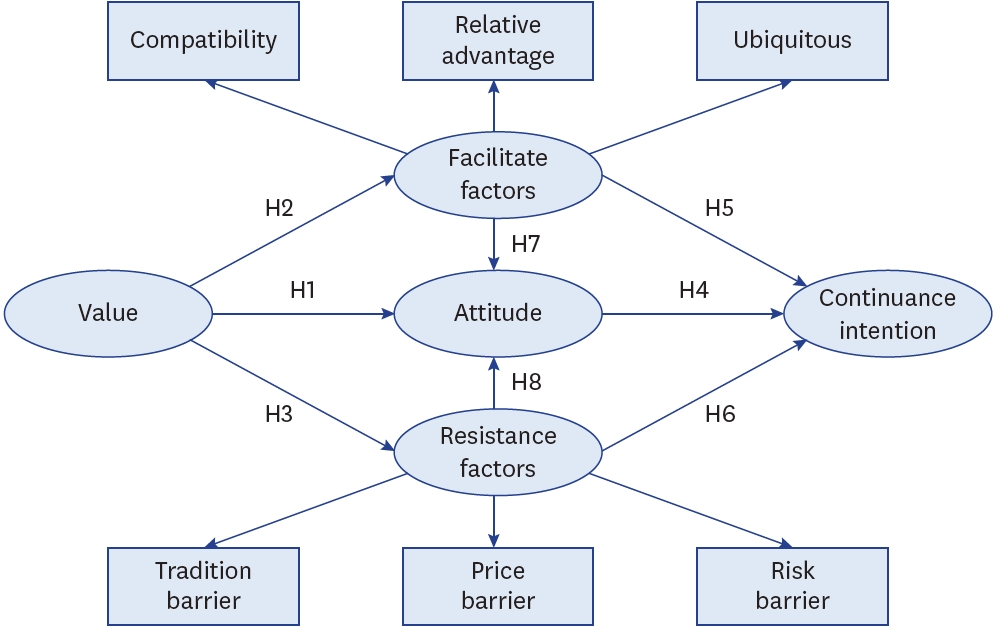
-
 Abstract
Abstract
 PDF
PDF - Objectives
Online grocery shopping has gained traction with the digital transformation of retail. This study constructs a behavioral model combining values, attitudes, and reasons for behavior—specifically, facilitators and resistance—to provide a more novel discussion and further understand the relative influences of the various factors affecting continuance intention in online grocery shopping.
Methods
Data were collected through an online questionnaire from consumers who had engaged in online grocery shopping during the past month in Seoul, Korea. All collected data were analyzed using descriptive analysis, and model validation was performed using partial least squares structural equation modeling.
Results
Continuance intention is primarily driven by facilitative factors (compatibility, relative advantage, and ubiquity). Attitude can also positively influence continuance intention. Although resistance factors (price, tradition, and risk) do not significantly affect continuance intention, they negatively affect attitude. Values significantly influence consumers’ reasoning processes but not their attitude.
Conclusions
These findings explain the key influences on consumers’ online grocery shopping behavior in Seoul and provide additional discussion and literature on consumer behavior and market management. To expand the online grocery market, consumers should be made aware of the potential benefits of the online channel; the barriers they encounter should be reduced. This will help sustain online grocery shopping behavior. Furthermore, its positive impact on attitude will further strengthen consumers’ continuance intention. -
Citations
Citations to this article as recorded by- Modelling the mass adoption potentials of fashion-augmented reality among the young consumers: evidence from an emerging economy
Mohima Akther, Mohammad Nurul Hassan Reza, Abdullah Al Mamun, Norzalita Abd Aziz, Marvello Yang
Journal of Fashion Marketing and Management: An International Journal.2025; 29(3): 459. CrossRef
- Modelling the mass adoption potentials of fashion-augmented reality among the young consumers: evidence from an emerging economy
- 6,732 View
- 82 Download
- 1 Crossref

- [English]
- Associations between the symptoms of gastroesophageal reflux disease and dietary and lifestyle behavior among young Korean adults: a preliminary cross-sectional study
- Soheun Shim, Jeong-Hwa Choi, Young-Ran Heo
- Korean J Community Nutr 2024;29(5):396-405. Published online October 31, 2024
- DOI: https://doi.org/10.5720/kjcn.2024.00011

-
 Abstract
Abstract
 PDF
PDF - Objectives
Gastroesophageal reflux disease (GERD) is a clinical condition caused by esophageal tissue damage resulting from the reflux of stomach or duodenal contents. An increasing number of GERD cases have been reported recently; however, research on this population, especially young adults, is lacking. This study aimed to investigate the dietary and lifestyle factors associated with GERD symptoms in young Korean adults. Methods: A total of 202 individuals (19–34 years old) living in Gwangju were surveyed using a questionnaire to examine their general characteristics, lifestyle, and dietary behaviors. GERD symptoms were investigated using the gastroesophageal reflux disease questionnaire (GerdQ). The participants were grouped into normal (GerdQ score ≤ 4) and caution (GerdQ score ≥ 5), and their characteristics were analyzed according to the group. Results: The findings suggested 15 participants (7.4%) belonged to the GERD caution group. More non-office workers were in the caution group than in the normal group (P < 0.05). The participants’ smoking, physical activity, sleep duration, and pillow height were not significantly different between the GERD phenotypes; however, the caution group consumed alcohol more frequently than the normal group (P < 0.001). The analyses of the participants’ eating behaviors revealed that the frequency of overeating, late-night snacking and chocolate consumption was significantly higher in the caution group (P < 0.001). Conclusion: Lifestyle and dietary behaviors were associated with GERD symptoms in young Korean adults. Further studies with larger cohorts are required to confirm these findings.
- 4,196 View
- 64 Download

- [English]
- Exploring the customer perceived value of online grocery shopping: a cross-sectional study of Korean and Chinese consumers using Means-End Chain theory
- Xinyu Jiang, Hyo Bin Im, Min A Lee
- Korean J Community Nutr 2024;29(4):318-335. Published online August 31, 2024
- DOI: https://doi.org/10.5720/kjcn.2024.00007
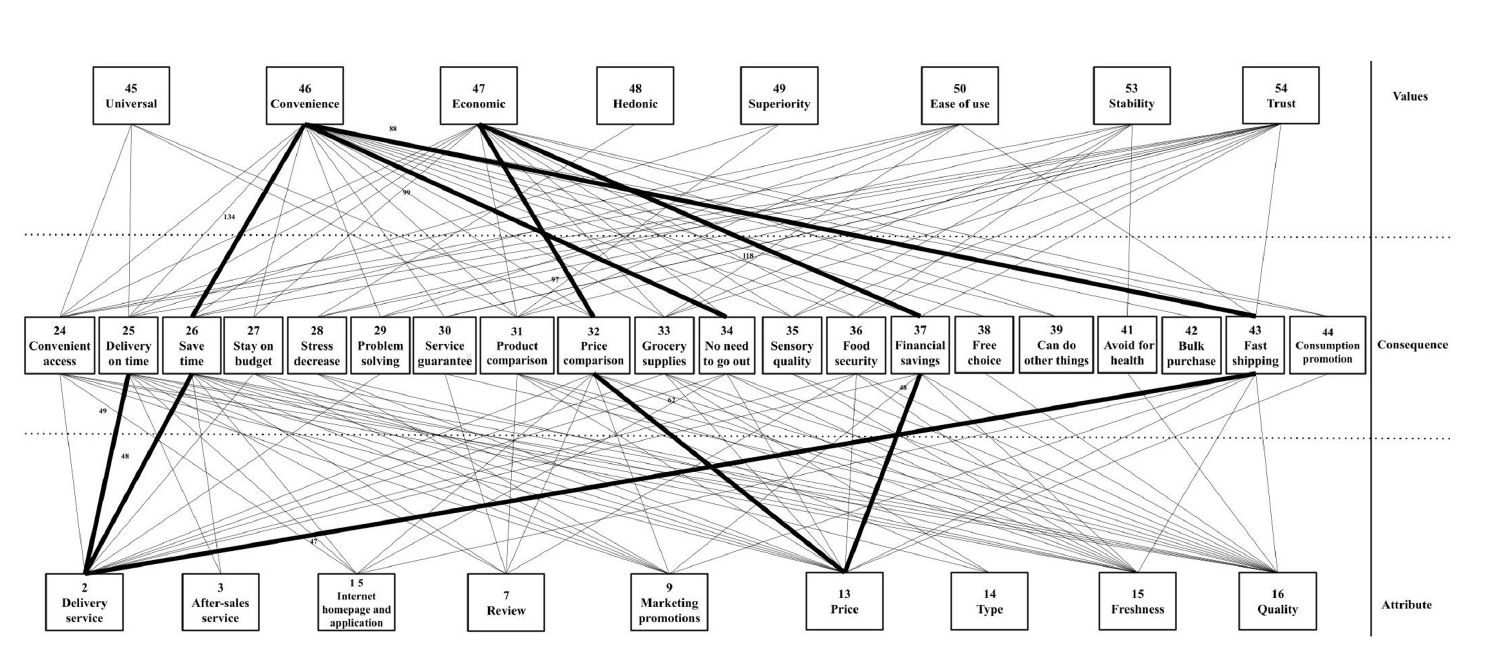
-
 Abstract
Abstract
 PDF
PDF - Objectives
Despite the growing market share of online grocery shopping, there is a need to understand customer perceived value due to the ongoing advancements in information technology. This study explores the connections between attributes, consequences, and values. Additionally, it conducts a cross-country comparison of consumers’ online grocery shopping behaviors to gain a deeper understanding of consumer market segments and any potential variations among them.
Methods
Data was collected through an online questionnaire survey conducted from May 1 to 15, 2024, targeting 400 consumers in Seoul, Korea, and Shanghai, China, who have experience with online grocery shopping. The survey utilized the Means-End Chain theory and association pattern technique hard laddering. Data collation and analysis were conducted using the IBM SPSS Statistics 28.0 program. The LadderUX software was employed to analyze the links between attributes, consequences, and values and create the consumer purchasing process’s implication matrix and hierarchical value map (HVM).
Results
The study identified key attributes that influence online grocery shopping decisions, including delivery service, price, freshness, and quality. Korean consumers demonstrated a higher sensitivity to price (19.0%) and delivery service (17.0%). In contrast, Chinese consumers prioritized delivery service (15.0%) and after-sales service (14.8%). Commonly cited consequences included time saving (12.6% for Koreans, 11.3% for Chinese), whereas prevalent values encompassed convenience (36.8% for Koreans, 19.6% for Chinese) and economic value (26.6% for Koreans, 14.7% for Chinese). The HVM underscored these insights, highlighting diverse consumer preferences and country-specific nuances.
Conclusions
The findings highlight the current state of online food consumption and consumers’ value systems, revealing variations among countries. These findings offer empirical insights that can be used to create customized global marketing strategies that resonate with various consumer preferences and market dynamics. -
Citations
Citations to this article as recorded by- Beyond the stage: how performing arts tourism shapes tourist perceptions and destination image
Islam Elbayoumi Salem, Mohammed Ali Bait Ali Sulaiman, Enrico di Bella, Sara Preti, Mohamed Kamal Abdien, Ahmed Magdy
Journal of Hospitality and Tourism Insights.2025; : 1. CrossRef
- Beyond the stage: how performing arts tourism shapes tourist perceptions and destination image
- 4,498 View
- 73 Download
- 1 Crossref

- [English]
- Relationship of sodium index with the obesity indicators of university students in Daegu, South Korea: a cross-sectional study
- Young-Won Jang, Jian Ma, Yeon-Kyung Lee
- Korean J Community Nutr 2024;29(3):189-198. Published online June 30, 2024
- DOI: https://doi.org/10.5720/kjcn.2024.29.3.189
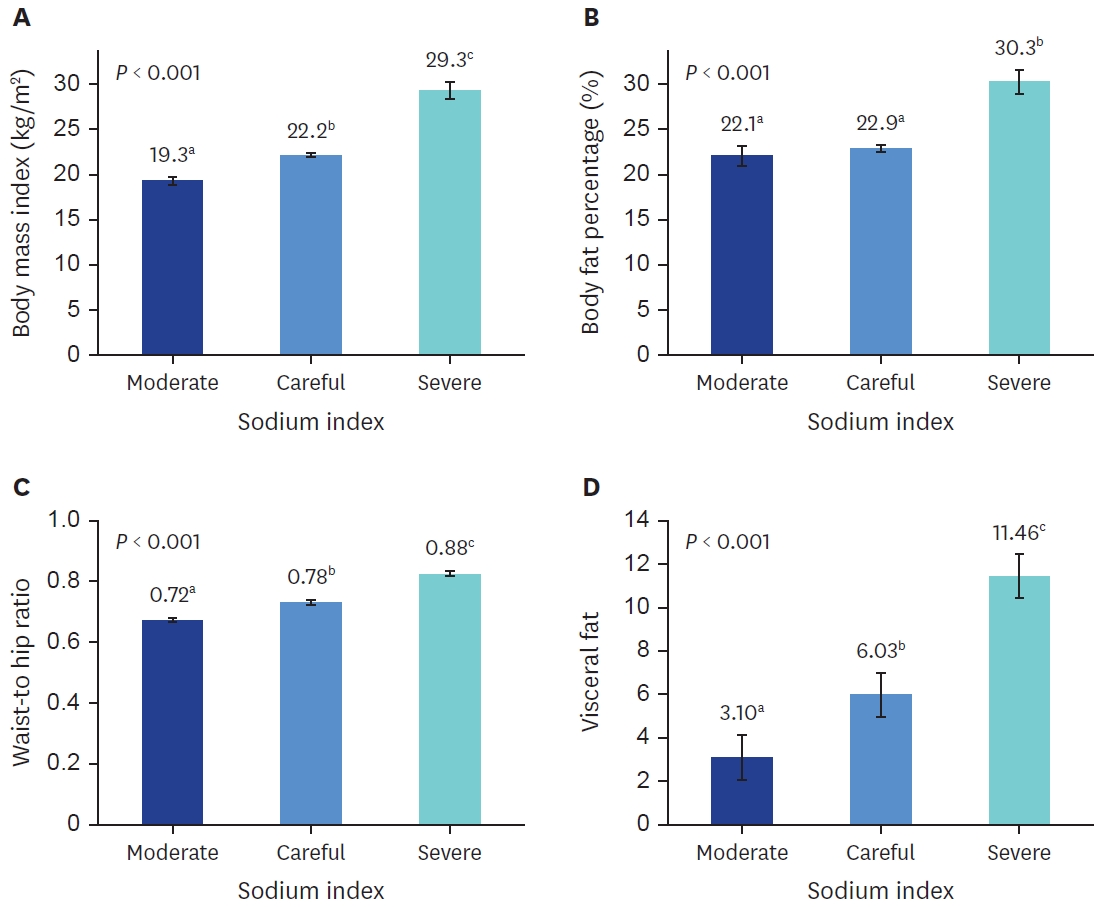
-
 Abstract
Abstract
 PDF
PDF - Objectives
The sodium index is an index that converts the estimated sodium intake calculated using a verified and reliable sodium estimation formula. This study aimed to determine the relationship between the sodium index and obesity indicators and the potential impact of excessive sodium consumption on obesity.
Methods
Obesity indicators, such as body mass index (BMI), body fat percentage, waist-to-hip ratio (WHR), and visceral fat levels, were analyzed in 120 university students (60 men and 60 women). The sodium index was calculated by indexing the estimated sodium intake according to age, sex, BMI, salt-eating habits, and salt-eating behaviors. The relationship between sodium index and obesity indicators was analyzed using multiple logistic regression.
Results
The estimated sodium intake was 3,907.1 mg, with 76.7% of the participants categorized under the “careful” level of sodium index and 10.8% under the “moderate” level. As the sodium index increased, the BMI, body fat percentage, WHR, and visceral fat levels significantly increased. All obesity indicators significantly increased in patients with a “severe” sodium index than in those with a “moderate” sodium index. In addition, a strong positive correlation was identified between obesity indicators and sodium index. When the “severe” sodium index was compared with the “moderate” sodium index, the risk of obesity based on body fat percentage increased by 2.181 times (95% confidence interval [CI], 1.526–3.118), while the risk of obesity based on visceral fat level increased by 4.073 times (95% CI, 2.097–7.911).
Conclusions
Our findings suggest a correlation between excessive sodium intake and obesity. Moreover, the sodium index can be used to determine sodium intake.
- 4,032 View
- 41 Download

- [English]
- Eating habits and dietary supplement utilization according to food-related lifestyle among Korean adults: a cross-sectional study
- EunJung Lee, Jin A Jang, Ji-Myung Kim
- Korean J Community Nutr 2024;29(4):253-264. Published online August 31, 2024
- DOI: https://doi.org/10.5720/kjcn.2024.00017
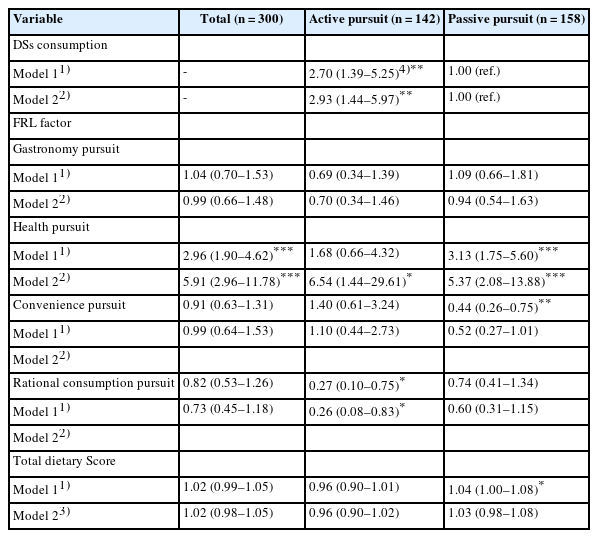
-
 Abstract
Abstract
 PDF
PDF - Objectives
This study investigated the association between eating habits and the utilization of dietary supplements (DSs) according to food-related lifestyle (FRL) among Korean adults. Methods: This study included a total of 300 participants (150 men and 150 women) in their 20s to 60s living in Seoul and Gyeonggi Province. We identified two groups by factor and cluster analysis: an ‘active pursuit’ group and a ‘passive pursuit’ group. Differences in eating habits and DS utilization between the two groups were analyzed by chi-square test and t-test. Logistic regression analysis was used to analyze the effect of variables on DS consumption according to FRL. Results: There were significant differences between the two groups in terms of age, alcohol drinking frequency, total dietary score, change in DS consumption after coronavirus disease 2019, and current DS consumption (P < 0.05). The proportion who perceived many health benefits of DSs was higher in the ‘active pursuit’ group than in the ‘passive pursuit’ group (P = 0.003). The most commonly consumed type of DSs was multivitamins & minerals for the ‘active pursuit’ group, and omega-3 fatty acids for the ‘passive pursuit’ group. The ‘an active pursuit’ group consumed DSs 2.93 times more (95% confidence interval [CI]: 1.44–5.97) compared to the ‘passive pursuit’ group, after adjusting for confounders. In the ‘active pursuit’ group, the health pursuit (odds ratio [OR] = 6.54, 95% CI: 1.44– 29.61) and rational consumption pursuit factors (OR = 0.26, 95% CI: 0.08–0.83) were associated with DS consumption, whereas only the health pursuit factor had a significant association (OR = 5.37, 95% CI: 2.08–13.88) within the ‘passive pursuit’ group. However, total dietary score and DSs consumption did not show a relationship. Conclusions: By understanding the consumption characteristics of DSs according to FRL, this can serve as basic data necessary for promoting health through the utilization of DSs and healthy behaviors. -
Citations
Citations to this article as recorded by- Discovering Vitamin-D-Deficiency-Associated Factors in Korean Adults Using KNHANES Data Based on an Integrated Analysis of Machine Learning and Statistical Techniques
Hongryul Ahn, Seungwon Kim, Jinmyung Jung, Chan Park
Nutrients.2025; 17(4): 618. CrossRef
- Discovering Vitamin-D-Deficiency-Associated Factors in Korean Adults Using KNHANES Data Based on an Integrated Analysis of Machine Learning and Statistical Techniques
- 3,878 View
- 94 Download
- 1 Crossref

- [English]
- Effects of a nutrition education program on metabolic syndrome risk factors in middle-aged Korean adults: an intervention study
- Minji Kang, Young-Hee Park, Subeen Kim, Eunyoung Tak, Hyun Wook Baik, Hee Young Paik, Hyojee Joung
- Korean J Community Nutr 2024;29(4):265-277. Published online August 31, 2024
- DOI: https://doi.org/10.5720/kjcn.2024.00005
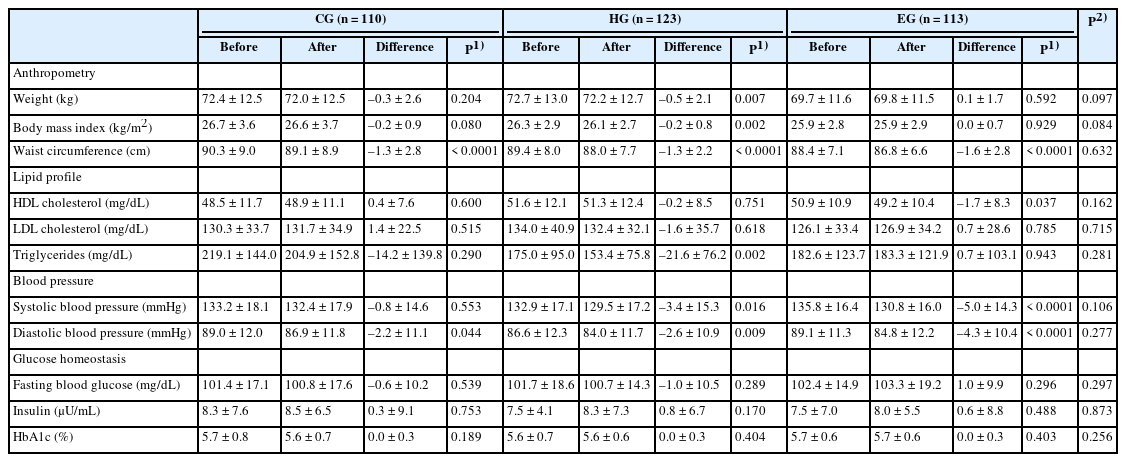
-
 Abstract
Abstract
 PDF
PDF - Objectives
This study was conducted to evaluate the effects of a nutrition education program on metabolic syndrome in middle-aged Korean adults.
Methods
A total of 411 Korean adults 30–59 years of age were allocated randomly into three groups: the nutrition education group for promoting Han-sik consumption (HG), the nutrition education group for eating balanced diet (EG), and the control group (CG). The HG and EG received four face-to-face nutrition education sessions over 16 weeks to improve nutritional problems based on the individual’ usual diet. Effectiveness of the program was evaluated with the differences of self-reported dietary behaviors, dietary intakes, anthropometric measurements and biochemical indices between the baseline and the end of the nutrition education program. The changes within groups were analyzed using paired t-test and McNemar test and effectiveness among three groups was analyzed by repeated analysis of variance.
Results
After the nutrition education, the percentages of participants who achieved the recommended food group consumption in the Korean Food Guidance Systems significantly increased in HG (P = 0.022). Body weight (P = 0.007), body mass index (P = 0.002), and triglycerides (P = 0.002) significantly decreased in HG. Waist circumference and diastolic blood pressure decreased in all three groups (P < 0.05).
Conclusions
This study found that tailored nutrition education program for middle aged Korean adults showed beneficial effects on improving dietary behaviors and metabolic syndrome risk factors. Further studies are needed to assess the long-term effects of the nutrition education programs on metabolic syndrome risks.
- 3,659 View
- 80 Download

- [English]
- The frequency of convenience food consumption and attitude of sodium and sugar reduction among middle and high school students in Seoul: a descriptive study
- Seoyeon Park, Yeonhee Shin, Seoyeon Lee, Heejung Park
- Korean J Community Nutr 2023;28(4):269-281. Published online August 31, 2023
- DOI: https://doi.org/10.5720/kjcn.2023.28.4.269
-
 Abstract
Abstract
 PDF
PDF - Objectives
This study aimed to examine the frequency of convenience food consumption at convenience stores (CVS) and the CVS usage patterns of middle and high school students as well as to understand students’ attitude toward sodium and sugar reduction.
Methods
We used an online questionnaire for data collection. The questionnaire comprised five distinct categories: general characteristics, CVS usage, frequency of consumption according to convenience food menus at CVS, attitude toward sodium and sugar reduction, and adherence to dietary guidelines.
Results
A total of 75 students from Seoul (14 middle school students and 61 high school students) participated in the study. Most respondents visit CVS 3-5 times a week. CVS are predominantly used during weekdays, mostly during lunch, and dinner. The students mostly checked the caloric content and expiration date as food labeling information. The participants were aware of the need to reduce their sugar and sodium intake. Among frequent CVS convenience food consumers, there was an increased consideration of the need to reduce their sugar and sodium consumption, despite their actual selection of foods with high sugar and sodium content. Additionally, they did not check the sugar and sodium levels indicated in food labeling. Further, the dietary action guide from the Ministry of Health and Welfare were poorly followed by most students.
Conclusions
There is a need for nutrition education specifically addressing the sugar and sodium content of the convenience foods predominantly consumed by students. Additionally, educating students with frequent convenience food consumption to actively check the sugar and sodium information on food labels could help promote healthier food choices. -
Citations
Citations to this article as recorded by- Co-occurrence network and pattern of school lunch using big data and text-mining using data from the 2021–2023 school meal menu information on the NEIS open educational information portal: an exploratory study
Hyeyun Kang, Jimi Kim
Korean Journal of Community Nutrition.2024; 29(6): 514. CrossRef
- Co-occurrence network and pattern of school lunch using big data and text-mining using data from the 2021–2023 school meal menu information on the NEIS open educational information portal: an exploratory study
- 3,018 View
- 26 Download
- 1 Crossref

- [Korean]
- Comparative study on the health and dietary habits of Korean male and female adults before and after the coronavirus disease 2019 pandemic: utilizing data from the 8th Korea National Health and Nutrition Examination Survey (2019–2021)
- Chaemin Kim, Eunjung Kim
- Korean J Community Nutr 2024;29(1):65-80. Published online February 29, 2024
- DOI: https://doi.org/10.5720/kjcn.2024.29.1.65
-
 Abstract
Abstract
 PDF
PDF - Objectives
This study aims to compare changes in physical factors, health behaviors, eating habits, and nutritional intake among Korean male and female adults over a period of three years (2019–2021) before and after the outbreak of coronavirus disease 2019 (COVID-19).
Methods
This study utilized raw data from the 8th Korea National Health and Nutrition Examination Survey (2019–2021). The participants in this study included 6,235 individuals in 2019, 5,865 individuals in 2020, and 5,635 individuals in 2021. Individuals whose daily energy intake was less than 500 kcal or exceeded 5,000 kcal were excluded from the study.
Results
In comparison to 2019, overweight/obesity rates, weight, waist circumference, weekend sleep hours, and resistance exercise days/week increased in both male and female during the COVID-19 pandemic. Regarding eating habits, the proportions of people skipping breakfast, not eating out, consuming health supplements, and recognizing nutritional labels increased in 2020 and 2021, whereas the rate of skipping dinner decreased. Total energy intake has continued to decrease for the two years since 2019. A comparison of nutrient intake per 1,000 kcal before and after the outbreak of COVID-19 revealed that intake of nutrients, including protein, phosphorus, iron, vitamin A, riboflavin, and niacin increased, while folic acid intake decreased. In male, calcium, phosphorus, riboflavin, and niacin intakes increased, whereas iron, vitamin C, and folic acid intakes decreased. In female, phosphorus, iron, vitamin A, and riboflavin intake increased significantly, while protein and niacin intake decreased significantly.
Conclusions
After COVID-19, the obesity rate, breakfast skipping rate, health supplement intake, and nutritional label use increased, while the frequency of eating out, dinner skipping rate, and total energy intake decreased. These environmental changes and social factors highlight the need for nutritional education and management to ensure proper nutritional intake and reduce obesity rates in the post-COVID-19 era. -
Citations
Citations to this article as recorded by- Status of Use of Protein Supplement Products according to the Health Concerns of Adults in Their 20s and 30s
Cho-In Oh, Bok-Mi Jung
Journal of the East Asian Society of Dietary Life.2025; 35(1): 9. CrossRef - A study on regional differences in dietary behaviors and satisfaction in Korea focusing on urban and rural comparisons: a cross-sectional study
Jong-Youn Rha, Sohyun Kim, Hae-Rang Lee, Juhyeon Kil
Korean Journal of Community Nutrition.2025; 30(2): 140. CrossRef - How Did the Dietary Behavior of Older Korean Adults Change During the COVID-19 Pandemic?
Yong-Seok Kwon, Dasol Kim, Hee-Sook Lim
Nutrients.2025; 17(12): 1973. CrossRef - Intake of energy and macronutrients according to household income among elementary, middle, and high school students before and during the COVID-19 pandemic: a cross-sectional study
Chae-Eun Jeong, Heejin Lee, Jung Eun Lee
Korean Journal of Community Nutrition.2024; 29(3): 234. CrossRef - 성인 남녀의 먹방 시청시간에 따른 식행동에 대한 연구
하얀 남, 복미 정, 은례 전
Korean Journal of Food and Cookery Science.2024; 40(4): 275. CrossRef
- Status of Use of Protein Supplement Products according to the Health Concerns of Adults in Their 20s and 30s
- 4,778 View
- 81 Download
- 5 Crossref

- [English]
- Safety education status and needs priorities of Korean military food service personnel using the Borich Needs Assessment and the Locus for Focus model: a cross-sectional study
- Jeongeun Park, Eunsil Her
- Korean J Community Nutr 2025;30(4):261-273. Published online August 29, 2025
- DOI: https://doi.org/10.5720/kjcn.2025.00185

-
 Abstract
Abstract
 PDF
PDF - Objectives
Since the enactment of the Serious Accidents Punishment Act in Korea in 2021, the importance of safety management in food service facilities has increased. This study was conducted to examine the status of safety education and to identify educational needs for safety accident prevention among army food service personnel.
Methods
This study included 157 food service personnel from Army units located in Gyeongsangnam-do. Participants were divided into two groups based on the daily number of meals served. Demographic characteristics, the status of safety education, and priority for safety accident prevention education were evaluated.
Results
A total of 97.5% of participants received safety education, with 60.8% attending at least monthly. “Lecture” (63.4%) was the most commonly used educational method. The preferred educational methods were “Lecture” (23.5%) and “Counselling” (23.5%), showing significant group differences (P < 0.001). A total of 79.6% of participants reported applying the educational content in their performance. The mean importance score for safety accident prevention (4.78) was higher than the performance score (4.44), with significant differences between the two groups observed in the importance scores (P < 0.05). “Slip & burn” had the highest importance score, while “Electric shock and fire” had the highest performance score. The educational needs analysis revealed that the highest priority item for the < 100 meals group was “When moving heavy items, an assistive device or assistance from colleagues should be utilized”, while for the ≥ 100 meals group, it was “When using a vegetable cutter or grinder, use an exclusive stick.”
Conclusion
This study can serve as a foundational database for developing customized safety education programs tailored to Korean army food service personnel.
- 1,625 View
- 23 Download

- [English]
- Dietary intake and food sources of essential fatty acids among Korean adolescents: a cross-sectional study based on the 2016–2021 KNHANES data
- Enkhgerel Erdenetsetseg, Hye Ran Shin, SuJin Song
- Korean J Community Nutr 2024;29(2):144-155. Published online April 24, 2024
- DOI: https://doi.org/10.5720/kjcn.2024.29.2.144
-
 Abstract
Abstract
 PDF
PDF - Objectives
This study evaluated dietary intake and food sources of essential fatty acids in Korean adolescents.
Methods
This study was comprised of 3,932 adolescents (9–18 years) who participated in the 2016–2021 Korea National Health and Nutrition Examination Surveys. Dietary intake and food sources of essential fatty acids, including alpha-linolenic acid (ALA), eicosapentaenoic acid (EPA), docosahexaenoic acid (DHA), and linoleic acid (LA) were evaluated using data obtained from one-day 24-hour dietary recall. The proportions of adolescents consuming ALA, EPA + DHA, and LA above or below the adequate intake (AI) of the 2020 Dietary Reference Intakes for Koreans were calculated. All statistical analyses accounted for the complex sampling design effect and appropriate sample weights.
Results
The mean intakes of ALA, EPA, DHA, and LA among Korean adolescents were 1.29 g/day, 69.6 mg/day, 166.0 mg/day, and 11.1 g/day, respectively. Boys had higher intakes of all essential fatty acids compared to girls. By age group, adolescents aged 15–18 years showed lower intakes of EPA and DHA compared to adolescents in younger age groups. The 9–11-year-old adolescents had lower intakes of ALA and LA than older adolescents. The proportions of adolescents who consumed more than AI were 35.7% for ALA, 30.4% for EPA + DHA, and 41.5% for LA. Adherence to the AI for ALA did not differ by sex or age group, although boys showed a lower adherence to the AI for EPA + DHA than girls. Major food sources for ALA and LA were plant-based oils, mayonnaise, pork, and eggs. Mackerel was the most significant contributor to EPA and DHA intake (EPA, 22.6%; DHA, 22.2%), followed by laver, squid, and anchovy.
Conclusions
The proportion of Korean adolescents who consumed EPA + DHA more than AI was low. Our findings highlight that nutrition education emphasizing an intake of essential fatty acids from healthy food sources is needed among Korean adolescents. -
Citations
Citations to this article as recorded by- Harnessing dietary polyunsaturated fatty acids through gut microbiota to enhance ferroptosis in breast cancer therapy
Yara Adel Haroun, Abdulrahman Abdulla Alzyoud, Mohammad Taha Alizadeh, Nashwa Ahmed Mohamed, Riyad Bendardaf, Sameh S.M. Soliman
Nutrition Research.2025; 141: 10. CrossRef
- Harnessing dietary polyunsaturated fatty acids through gut microbiota to enhance ferroptosis in breast cancer therapy
- 3,147 View
- 57 Download
- 1 Crossref

- [Korean]
- Survey on consumer perceptions, health benefits and preferences of kindergarten and school foodservices in Korea, including related keywords reported in newspaper: a mixed-methods study
- Gyoungok Gang, Chaewon Park, Hyeja Chang
- Korean J Community Nutr 2025;30(4):309-320. Published online August 29, 2025
- DOI: https://doi.org/10.5720/kjcn.2025.00199

-
 Abstract
Abstract
 PDF
PDF - Objectives
With the rapid development of social culture, the perception of kindergarten and school foodservice, as well as opinions on its health benefits, has changed significantly. However, research on this topic remains scarce. We conducted a survey in South Korea on consumers’ perceptions, healthiness, and preferences regarding kindergarten and school foodservice.
Methods
With the nationwide cooperation of 17 city and provincial education offices, online and offline surveys were conducted targeting the parents of kindergarten and lower-grade elementary school children, as well as upper-grade elementary, middle, and high school students. In addition, keywords in newspaper reports were analyzed using the Big Kinds platform. A total of 532 valid questionnaires were collected, and statistical analysis was performed using IBM SPSS Statistics version 27.0 (IBM Co.).
Results
The average age of the parents and students was 40 and 12.5 years, respectively, with 36.4% of the students attending schools in the Seoul and Gyeonggi areas. The main keywords reported in newspaper articles, as analyzed using the Big Kinds platform, were “eco-friendly agricultural products,” “food ingredients,” “safety,” and “marine products.” The perception of kindergarten and school foodservice was very positive, especially regarding the attributes of safe ingredient use (4.44), menu variety (4.29), cafeteria cleanliness (4.31), cleanliness of plates, spoons, and utensils (4.24), thorough hygiene management (4.2), nutritional excellence (4.24), and support for proper eating habits (4.18). The healthiness of school foodservice was highly rated, although there is still room for improvement in terms of “not serving fried foods more than twice a week”. In terms of preference for school meals, the most preferred items were meat side dishes, followed by chicken, noodles, fried food, beverages, and bread. In contrast, soybean paste soup, vegetables, and mixed-grain rice received relatively low preference.
Conclusion
The results described above may be used to develop educational programs or policies that inform students and parents about the goals of school foodservice and help address common misunderstandings.
- 1,500 View
- 27 Download

- [English]
- The dietary factors associated with sleep duration in postmenopausal middle-aged women: a cross-sectional study using 2019–2023 Korea National Health and Nutrition Examination Survey data
- Eugene Shim
- Korean J Community Nutr 2025;30(3):197-213. Published online June 30, 2025
- DOI: https://doi.org/10.5720/kjcn.2025.00052
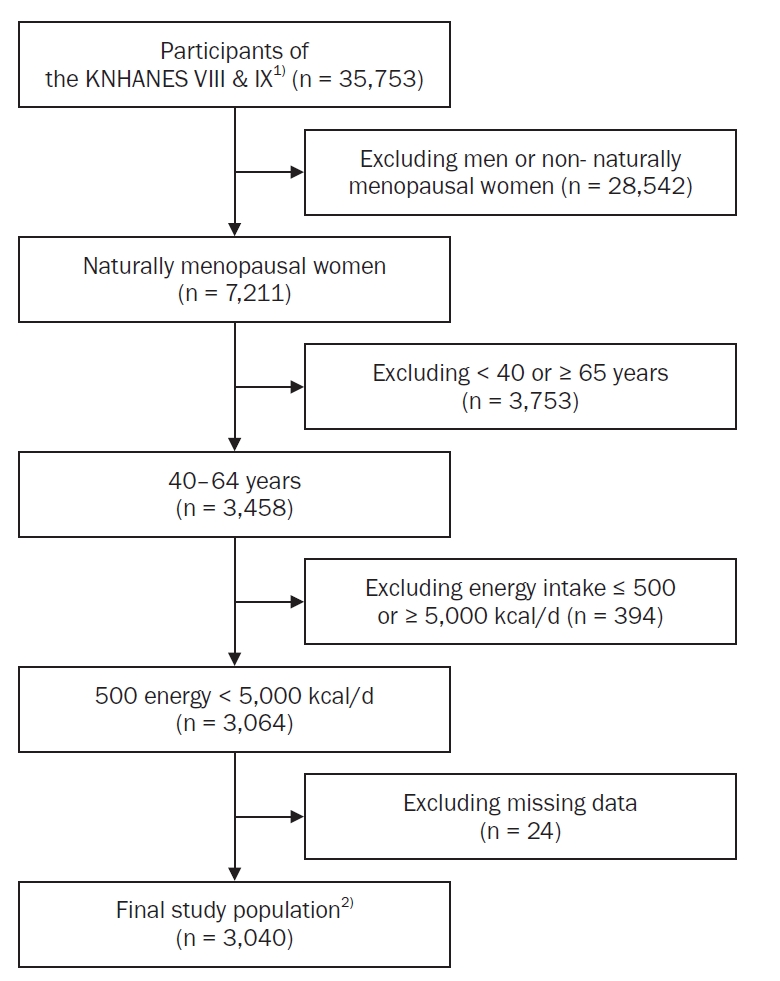
-
 Abstract
Abstract
 PDF
PDF - Objectives
This study aimed to analyze dietary factors associated with sleep duration in postmenopausal middle-aged women using data from the Korea National Health and Nutrition Examination Survey (KNHANES), with particular emphasis on the postmenopausal period.
Methods
A total of 3,040 postmenopausal women aged 40–64 years from the 2019–2023 KNHANES were included. Sleep duration was classified into four categories: “appropriate sleep duration” (ASD; 7–9 hours), “short sleep duration” (6–7 hours), “very short sleep duration” (VSSD; < 6 hours), and “long sleep duration” (LSD; > 9 hours). Nutrient and food intake were compared among groups using analysis of covariance. Multinomial logistic and polynomial regression models assessed associations, adjusting for demographic and health covariates.
Results
The VSSD group had higher body mass index and waist circumference than the ASD group, despite lower total energy intake, and also consumed more snack energy and skipped breakfast and dinner more often. This group also had lower intakes of monounsaturated fatty acids and nuts and seeds. In the late menopausal group, greater consumption of cereal grains, fish and shellfish, and beverages was associated with elevated LSD risk. Conversely, higher folate intake in the early menopausal group was inversely associated with VSSD risk. Cholesterol intake was positively associated with LSD risk in both groups. A negative nonlinear association between sleep duration and dietary intake was observed in the early menopausal group when polyunsaturated fatty acid intake exceeded 19.86 g/day and riboflavin intake exceeded 1.76 mg/day. In the late menopausal group, riboflavin intake was strongly correlated with increased LSD risk (odds ratio = 4.776, P = 0.004). Sugar and beverage intake showed a positive linear relationship with sleep duration at average intake levels.
Conclusion
Dietary factors associated with sleep duration differed by postmenopausal period, with specific nutrients and food groups exhibiting variable associations with sleep duration above mean intake levels.meS
- 2,981 View
- 35 Download

Research Note
- [English]
- Pilot evaluation of a cooking-based nutrition education program to promote vegetable intake among children in Seoul, South Korea: a single-group pre–post study
- Sil-Ah Kim, Su-Jin Lee, Min-Ah Kim, Ji-Eun Oh, Sohyun Park, Hyun-Joo Ryou, Ji-Yun Hwang
- Korean J Community Nutr 2025;30(4):249-260. Published online August 29, 2025
- DOI: https://doi.org/10.5720/kjcn.2025.00220

-
 Abstract
Abstract
 PDF
PDF - Objectives
Food neophobia in children is often associated with limited exposure and familiarity to some foods. Cooking-based nutrition education (CBNE), which promotes acceptance through direct experience, may support the development of healthy eating habits. This study aimed to develop and implement a standardized CBNE program for school-aged children in Seoul, South Korea, and to evaluate its effectiveness by assessing changes in raw vegetable intake. Raw vegetable intake is an early indicator of the effectiveness of nutrition education on diverse topics in promoting healthy eating habits.
Methods
A single-group pre–post study was conducted with 37 children aged 6–11 years who participated in a 2-day CBNE program in October 2023. The participants completed pre- and post-education questionnaires and raw vegetable intake assessments. Four low-preference vegetables (bell pepper, carrot, cucumber, and tomato) were selected and served raw (25 g each) before and after the program. Intake changes were analyzed using paired t-tests, and Pearson’s correlation and hierarchical regression analyses were performed to identify predictors.
Results
Total raw vegetable intake significantly increased post-education (P = 0.008), particularly for carrots (P = 0.023). By subgroup, raw vegetable intake significantly increased in girls, upper-grade students, and those who consumed four or more vegetable side dishes per meal. Hierarchical regression analysis revealed that while vegetable preference was initially significant, vegetable-related experiences (β = 0.395, P = 0.026) and diversity of vegetable side dishes per meal (β = 0.403, P = 0.032) were stronger predictors in the final model (adj R2 = 0.333).
Conclusion
The CBNE program may enhance vegetable intake in children. Although preference remained the strongest individual factor, vegetable experience and the diversity of vegetable side dishes per meal had a greater combined effect. These findings underscore the importance of repeated and diverse exposure, not only by supporting previous studies that link such exposure to increased intake but also by suggesting that environmental support may be essential for sustaining healthy eating habits.
- 1,314 View
- 51 Download

Research Articles
- [English]
- Impact of postoperative dietary types on nutrition and treatment prognosis in hospitalized patients undergoing oral and maxillofacial surgery: a comparative study
- Sung Bin Youn, Se-Hui Ahn, Dong-Ho Cho, Hoon Myoung
- Korean J Community Nutr 2024;29(2):129-143. Published online April 24, 2024
- DOI: https://doi.org/10.5720/kjcn.2024.29.2.129
-
 Abstract
Abstract
 PDF
PDF Supplementary Material
Supplementary Material - Objectives
The objective of this study is to compare a nutritionally balanced soft blend diet (SBD) with a soft fluid diet (SFD) on the health of inpatients who have undergone oral and maxillofacial (OMF) surgery, ultimately aiming to enhance care outcomes, improve health-related quality of life (QOL), and increase satisfaction with the hospital.
Methods
Thirty-two patients were randomized into two groups: sixteen received SFD and sixteen received SBD. Anthropometric, laboratory evaluations were conducted upon admission and discharge. Patients filled out questionnaires on demographics, diet satisfaction, food intake amount, and health-related QOL on the day of discharge, assessed using the EuroQoL 5 Dimensions 3 Level and EuroQoL Visual Analogue Scale (EQ-VAS) instruments. Data were analyzed with descriptive statistics, χ2 tests for group differences, and paired nonparametric t-tests for within-group comparisons. The Mann-Whitney U test evaluated inter-group differences in preoperative weight and body mass index (BMI), postoperative changes, meal satisfaction, intake, health-related QOL, and self-assessed health status. P-values were set at a significance level of 0.05.
Results
The SBD group had higher dietary intake (63.2% vs. 51.0%) and greater diet satisfaction (80.6 vs. 48.1, P < 0.0001) compared to SFD group. Health-related QOL, measured by EQ-VAS, was better in SBD group (70.3 vs. 58.8, P < 0.05). Postoperative weight and BMI decreased in SFD group but increased in SBD group (P < 0.01). Changes in laboratory results showed more stability in the SBD group. No postoperative infections were reported in SBD group, whereas SFD group had a 31.25% complication rate.
Conclusions
While SFD is often recommended after OMF surgery to protect oral wound healing process, our study reveals that SBD not only enhances physical and psychological outcomes but also, somewhat unexpectedly, supports wound healing and reduces complications. Essentially, SBD promotes physical recovery and enhances health-related QOL than SFD by supporting both somatic and mental healing aspects. -
Citations
Citations to this article as recorded by- Comparative Evaluation of Effect of Therapeutic Nutrition on Serum Albumin Levels and Nutritional Indices in Patients Undergoing Open Reduction and Internal Fixation for Maxillofacial Fractures – A Prospective Clinical Trial
B. R. Rajanikanth, Amruta T. Achar, Kavitha Prasad, Hema Arvind
Journal of Maxillofacial and Oral Surgery.2025; 24(1): 110. CrossRef - Nutritional management for breast cancer patients
Minjeong Kim, Minkyoung Lee, Jisun Sa
The Ewha Medical Journal.2025;[Epub] CrossRef - A Holistic Approach to Postendodontic Pain Management: A Narrative Review
Hmoud A. Algarni
Journal of Pharmacy and Bioallied Sciences.2024; 16(Suppl 5): S4262. CrossRef
- Comparative Evaluation of Effect of Therapeutic Nutrition on Serum Albumin Levels and Nutritional Indices in Patients Undergoing Open Reduction and Internal Fixation for Maxillofacial Fractures – A Prospective Clinical Trial
- 3,030 View
- 94 Download
- 3 Crossref

- [Korean]
- Nutritional status of North Koreans and related perceptions among South Korean adults
- Youngmin Nam, Jihyun Yoon
- Korean J Community Nutr 2024;29(4):288-303. Published online August 31, 2024
- DOI: https://doi.org/10.5720/kjcn.2024.00006

-
 Abstract
Abstract
 PDF
PDF - Objectives
North Koreans have been facing chronic food shortages and malnutrition. This study examined the nutritional status of North Koreans and the perceptions of South Korean adults regarding their nutritional status.
Methods
The nutritional status was examined using nutritional indicators for the general population, children, and reproductive-aged women in North Korea. An online survey was conducted among 1,000 South Korean adults aged 19–69 years to investigate their perceptions regarding the nutritional status of North Koreans.
Results
Although the nutritional status of children in North Korea has consistently improved, significant progress in the general population and reproductive-aged women in the country remains elusive. The prevalence of malnutrition among North Korean children has decreased to a level that is not considered severe based on international standards, although it shows a substantial difference from that among South Korean children. The prevalence of undernourishment and food insecurity in North Korea remains over 40%. South Korean adults perceive the nutritional status of North Koreans as being more severe than it is in reality. Notably, a significant inconsistency exists between the perceived and actual nutritional status of North Korean children, with over 95% of South Korean adults perceiving North Korean children’s malnutrition as being more severe than it actually is. Moreover, South Korean adults in their 20s to 40s tended to perceive the nutritional status of North Koreans as being more severe than those in their 50s to 60s did.
Conclusions
The nutritional status of North Koreans is a matter of concern. The disparity between South Koreans’ perceptions of the nutritional status of North Koreans and the actual status highlights the need for accurate information dissemination to effectively address malnutrition in North Korea. These efforts could be instrumental in enhancing public awareness and fostering social consensus on food aid and nutritional support programs for North Korea.
- 3,190 View
- 65 Download

- [Korean]
- Factors related to adolescent obesity and changes: a cross-sectional study based on the Korea Youth Risk Behavior Survey
- Bora Lee, Ho Kyung Ryu
- Korean J Community Nutr 2023;28(5):363-375. Published online October 31, 2023
- DOI: https://doi.org/10.5720/kjcn.2023.28.5.363
-
 Abstract
Abstract
 PDF
PDF - Objectives
The objective of this study was to identify factors associated with adolescent obesity, as well as any new factors that correlated with a change in the rate of obesity over time.
Methods
The study used 5-yearly data collected by the Korea Youth Risk Behavior Survey starting from the year 2006 up until 2021 (data from 2nd, 7th, 11th, and 17th surveys were analyzed). Factors such as demographics, dietary factors, health behavioral factors, and mental health factors were studied. All data were analyzed using IBM SPSS 27.0, employing chi-square tests and multiple logistic regression analysis.
Results
This study included data from a total of 255,200 participants. Factors contributing to obesity varied with time. Over the survey duration of 15 years, low academic achievement, parents with low levels of education, low frequency of fruit consumption, low frequency of fast food intake, long periods of being seated, and high levels of stress were significantly associated with a high rate of obesity. Factors that showed a new correlation with an increase in obesity rates included living with single parents, low frequency of muscle strengthening exercises, and experiencing intense sadness and despair in the past year. Factors that were correlated with a change in obesity rates over time included household economic status, frequency of carbonated beverage consumption, frequency of intense physical activity, and frequency of alcohol consumption. Breakfast intake and smoking were not significantly associated with obesity rates in the 15-year period.
Conclusions
While several factors associated with obesity remained consistent over time, several new factors have emerged in response to social, economic, and environmental changes contributed to a change in obesity rate over time. Therefore, to prevent and manage adolescent obesity, continuous research into the new emergent factors contributing to obesity is needed. -
Citations
Citations to this article as recorded by- Effects of watching Mukbang and Cookbang videos on adolescents’ dietary habits and mental health: cross-sectional study using the 18th Korea Youth Risk Behavior Survey
Seung-Hee Hong
Korean Journal of Community Nutrition.2024; 29(2): 156. CrossRef
- Effects of watching Mukbang and Cookbang videos on adolescents’ dietary habits and mental health: cross-sectional study using the 18th Korea Youth Risk Behavior Survey
- 2,467 View
- 46 Download
- 1 Crossref

- [Korean]
- Health behaviors and eating habits in people’s 20s and 30s according to food content usage level on social media: a cross-sectional study
- Seo-Yeon Bang, Bok-Mi Jung
- Korean J Community Nutr 2023;28(5):392-403. Published online October 31, 2023
- DOI: https://doi.org/10.5720/kjcn.2023.28.5.392
-
 Abstract
Abstract
 PDF
PDF - Objectives
This study was intended to investigate adults’ health behaviors and eating habits according to their levels of social media use.
Methods
From May 27 to July 11, 2022, an online survey was conducted of 452 male and female social media users in their 20s and 30s, and their eating habits and health behaviors were compared and analyzed according to their degree of social media use. For each of the three levels of food content use, the frequency of social media content use, and the total score range of average social media viewing time per day were divided into three parts, and a group with a score of less than 2 points was classified as low-use; a group with a score of 2 or more and less than 3 points was classified as middle-use; and a group with a score of 3 points or more was classified as high-use.
Results
The use of food content was higher in women than in men (P < 0.001), and higher in those in their 20s than in those in their 30s (P < 0.001). The group with a high level of food content use showed a higher rate of post-use hunger than the group with a low level (P < 0.01). The experience of eating after using food content was also higher in the group with a high level of use than in the group with a low level of use (P < 0.001). The group with a normal or high level of food content use had more negative eating habits than the group with a low level.
Conclusions
The study highlighted the need to provide desirable food content to people in their 20s and 30s with negative eating habits and to promote them so that they can use the right healthy nutrition–related content. -
Citations
Citations to this article as recorded by- The relationship between smartphone usage and eating behavior for elementary school students in Gangneung, South Korea: cross-sectional study
Minji Kim, Meera Jang
Korean Journal of Community Nutrition.2024; 29(4): 278. CrossRef
- The relationship between smartphone usage and eating behavior for elementary school students in Gangneung, South Korea: cross-sectional study
- 3,398 View
- 96 Download
- 1 Crossref

- [English]
- Developing educational videos to inform rightly about school foodservice from kindergarten to high school: a case study
- Gyoungok Gang, Chaewon Park, Haejin Kang, Wan Soo Hong, Yoo Kyoung Park, Sook Hee Choi, Seung Hye Kim, Jieun Choi, Jihyun Park, Hyeja Chang
- Korean J Community Nutr 2024;29(2):97-113. Published online April 24, 2024
- DOI: https://doi.org/10.5720/kjcn.2024.29.2.97
-
 Abstract
Abstract
 PDF
PDF - Objectives
Since the enactment of the School Nutrition Act in 1981, school lunch programs in South Korea have grown quantitatively and qualitatively with a current student participation rate of 99.8%. Nonetheless, educational materials are needed to reduce misunderstanding and ignorance about school lunch programs. This study aimed to develop 3 educational videos that help students of various ages (kindergarteners/lower-grade elementary, upper-grade elementary, and secondary school, respectively), understand the school lunch program.
Methods
A scenario was created, was made, and the opinions on the scenario from experts in foodservice sectors were collected. A survey was conducted to students and parents to determine topics they wanted to know about school foodservice. The final videos were produced using this information and the expert opinions. The data were analyzed using SPSS 27.0 for Mac (IBM Corp., Armonk, NY, USA); a P-value of < 0.05 was considered significant.
Results
Three videos on school foodservice were developed for various age levels of students: kindergarten/lower-grade elementary, upper-grade elementary, and secondary school. Additionally, English subtitles were included for the multicultural student population. These videos, each lasting about 7 minutes, cover topics such as nutrition, hygiene, and the cultural significance of the school lunch program. The survey results showed that parents and students wanted to know the following topics about the school lunch program: “nutritionally balanced diet” (11.9%), “purchasing safe food ingredients” (10.9%), and “healthy eating habits” (9.9%).
Conclusions
The developed videos will serve as valuable educational resources on school foodservice, foster a deeper understanding of the school lunch program in parents and students, and potentially address their inquiries regarding production processes, nutrition, hygiene, cultural heritage, and health.
- 2,409 View
- 37 Download

- [English]
- The relationship between smartphone usage and eating behavior for elementary school students in Gangneung, South Korea: cross-sectional study
- Minji Kim, Meera Jang
- Korean J Community Nutr 2024;29(4):278-287. Published online August 31, 2024
- DOI: https://doi.org/10.5720/kjcn.2024.00002
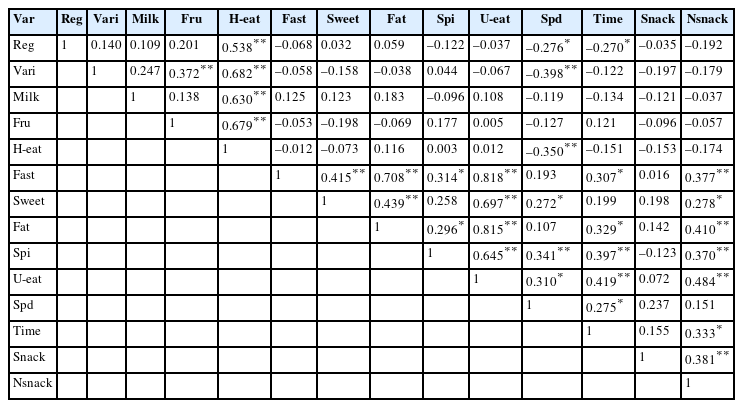
-
 Abstract
Abstract
 PDF
PDF - Objectives
This study investigates the relationship between smartphone usage and eating behavior among elementary school students. Methods: This survey was conducted on 4th- to 6th-grade students at elementary schools in Gangneung from September 6th to September 15th, 2023. Of the 129 copies of the questionnaire that were distributed to 5 schools, 66 copies (51.2%) were returned. Results: Compared to the nationwide statistics, the smartphone ownership rate of elementary school students in Gangneung was lower, but the rate of smartphone overdependence was higher. Smartphone dependence was 21.12 points for study subjects and 26.00 points for the overdependence risk group (Org). Compared to national statistics, the self-control failure factor was higher, so study participants in Gangneung City are thought to have great difficulty with self-control. The Org’s weekend smartphone use time of 7.54 hours was significantly more than the general user group (Gug)’s 4.06 hours. The number of days in which the Org consumed late-night snacks per week was 2.92 days, and the Gug had 2.15 days, but the difference was not significant. Eating fast food showed a positive correlation with eating sweet food, eating fatty food, and eating heavily seasoned food. It was found that frequent consumption of fast food is closely correlated with unhealthy eating behavior. Weekend smartphone use time showed a significant positive correlation with smartphone dependence and the number of days late-night snacks consumed per week. Conclusions: Study participants in Gangneung are more dependent on smartphones than national statistics. Smartphone dependence had a negative correlation with healthy eating behavior and a correlation with average unhealthy eating behavior.
- 2,324 View
- 50 Download

- [Korean]
- Effects of night eating on oral health characteristics and symptoms of poor oral health in adolescents: a cross-sectional study using the 18th Korea Youth Risk Behavior Survey
- Seung–Hee Hong
- Korean J Community Nutr 2025;30(2):150-162. Published online April 29, 2025
- DOI: https://doi.org/10.5720/kjcn.2025.00038

-
 Abstract
Abstract
 PDF
PDF - Objectives
To determine the association between night eating habits and oral health in adolescents.
Methods
Data from the 18th Korea Youth Risk Behavior Survey conducted in 2022 were analyzed. The study included 51,850 middle and high school students and assessed the frequency of night eating per week, dietary habits, oral health characteristics, and factors affecting the presence of symptoms of poor oral health.
Results
Almost thirty-seven percent (36.6%) of Korean adolescents have eaten at night one to two times per week and 23.0% more than three times per week. An increased frequency of night eating was associated with poor dietary habits. Adolescents who consumed more at night were less likely to have breakfast, drink water, and eat fruit, while their consumption of fast food, sweet drinks, and high-caffeine drinks increased (P < 0.001). An increased frequency of night eating was also associated with poor oral health. In a logistic regression analysis, more frequent night eaters were significantly less likely to brush their teeth at least three times per day (odds ratio [OR], 0.78; 95% confidence interval [CI], 0.75–0.82; P for trend < 0.001), and brush their teeth before going to sleep (OR, 0.70; 95% CI, 0.65–0.75; P for trend < 0.001), while they were more likely to experience sealant (OR, 1.19; 95% CI, 1.13–1.26). More frequent night eaters were significantly more likely to have tooth fracture (OR, 1.41; 95% CI, 1.30–1.53; P for trend < 0.001), tooth pain when eating (OR, 1.59; 95% CI, 1.50–1.67; P for trend < 0.001), toothache (OR, 1.60; 95% CI, 1.52–1.70), and bad breath (OR, 1.51; 95% CI, 1.43–1.60).
Conclusion
Our findings suggest that frequent night eating is linked to symptomatically poor oral health in adolescents. Therefore, oral health education programs related to dietary habits are necessary to reduce the potential of night eating to negatively influence dietary habits and oral health.
- 2,073 View
- 57 Download

- [Korean]
- Knowledge on complementary foods of mothers with young children and their perception of convenience complementary foods
- Yoojeong Joo, Jihyun Yoon, Linxi Huang, Youngmin Nam
- Korean J Community Nutr 2024;29(1):16-33. Published online February 29, 2024
- DOI: https://doi.org/10.5720/kjcn.2024.29.1.16
- Correction in: Korean J Community Nutr 2024;29(2):171
-
 Abstract
Abstract
 PDF
PDF - Objectives
The purpose of this study was to examine mothers’ knowledge levels on complementary foods and their perception of convenience complementary foods.
Methods
An online survey was conducted with mothers aged 20–49 years who had purchased convenience complementary foods and had a preschool child aged 4 months or older. The respondents were categorized into 3 groups based on their knowledge scores: low- (0–50 points), mid- (55–65 points), and high- (70–100 points) knowledge groups.
Results
The average score of mothers’ knowledge on complementary foods was 58.8 out of 100 points. Working mothers were found to have lower levels of knowledge compared to mothers who were housewives. Only 1/4 of responding mothers had educational experience on complementary foods. Mothers expressed a desire for information on the types of complementary foods (72.2%) and the intake amounts (60.3%) corresponding to each phase of their child’s development. Multivariate analysis of variance revealed significant differences in health (P = 0.002), variety (P = 0.039), and hygiene (P = 0.041) among the factors taken into consideration when purchasing convenience complementary foods according to the mothers’ knowledge levels. Mothers in the high-knowledge group placed a greater importance on ‘balanced nutrition’ (P = 0.022) and ‘hygienic cooking’ (P = 0.010) compared to mothers in the low-knowledge group. The results of the modified importance-performance analysis, which compared the importance and performance of the factors taken into consideration when purchasing convenience complementary foods, highlighted the need for efforts in ‘health,’ ‘hygiene,’ and ‘price,’ while also indicating an excessive effort in ‘convenience.’
Conclusions
This study suggests expanding relevant education programs to enhance mothers’ knowledge on complementary foods, especially for working mothers. In the industry, marketing strategies for complementary food products could be developed that align with the needs of mothers, focusing on health, hygiene, and price. -
Citations
Citations to this article as recorded by- Development and Evaluation of a Nutrition Education Website for the Prevention and Management of Childhood Obesity
Miyong Yon, Chan Park, Kwan-Hee Yoo, Taisun Hyun
Korean Journal of Community Nutrition.2012; 17(4): 390. CrossRef - Breakfast Skipping and Related Factors in Children in Poverty
Kyung Ja June, Jin-Young Kim, Seungmi Park, Ji Yun Lee
Journal of Korean Academy of Community Health Nursing.2011; 22(2): 204. CrossRef
- Development and Evaluation of a Nutrition Education Website for the Prevention and Management of Childhood Obesity
- 2,919 View
- 66 Download
- 2 Crossref

- [English]
- Associations between diet quality and regional factors in Korea vary according to individuals’ characteristics: a cross-sectional study
- Hyunmi Han, Clara Yongjoo Park, Jeonghwa Lee
- Korean J Community Nutr 2025;30(4):274-285. Published online August 29, 2025
- DOI: https://doi.org/10.5720/kjcn.2025.00157

-
 Abstract
Abstract
 PDF
PDF Supplementary Material
Supplementary Material - Objectives
Although diet quality is known to be associated with environment and individuals’ characteristics, these have not been studied together. We determined the association of diet quality with regional factors stratified by individuals’ sociodemographic characteristics.
Methods
This study used nationally representative survey data on regional factors (2010–2020) and the Korea National Health and Nutrition Examination Survey data on individuals’ sociodemographic characteristics (2013–2018). Community-dwelling Koreans aged ≥ 20 were included (n = 26,853). Regions were categorized into metropolitan cities or provinces and subsequently according to regional factors (level of educational attainment, income per capita, food security status, physical activity facilities, time to the nearest large retailer, and internet use of the region). Individuals’ sociodemographic characteristics included age, education status, income, and number of household members. Diet quality was assessed using the Korean Healthy Eating Index (KHEI).
Results
In the entire population, education status of metropolitan cities was positively associated with the KHEI. Shorter time to retailers and higher internet use were positively associated with the KHEI in metropolitan residents with higher income levels but negatively associated with the KHEI in those with lower income status. Among provincial residents with a low education status or income, regional physical activity facilities were positively associated with the KHEI.
Conclusion
The association between diet quality and regional factors varied depending on the resident’s sociodemographic characteristics. Both regional and individual sociodemographic factors must be considered to address gaps in nutritional equity.
- 1,001 View
- 20 Download

- [English]
- Nutrition quotient for preschoolers and key impacting factors in Korea: a cross-sectional study on food literacy, social support, and the food environment of primary caregivers
- Danbi Gwon, Ji-Yun Hwang, Jieun Oh
- Korean J Community Nutr 2025;30(1):16-26. Published online February 28, 2025
- DOI: https://doi.org/10.5720/kjcn.2024.00311

-
 Abstract
Abstract
 PDF
PDF - Objectives
This study evaluated the nutrition quotient for preschoolers (NQ-P) and analyzed the impact of key factors, such as caregivers’ food literacy, social support, and food environment, on the eating habits of preschool children in Korea. This study also sought to provide foundational data for developing tailored nutrition education programs by identifying the nutrition education needs of caregivers.
Methods
This study was conducted among caregivers of preschool children (aged 0–6 years) using an online self-administered survey conducted from August 22 to August 28, 2023. A total of 1,116 survey responses were analyzed. This study assessed children’s NQ-P score, caregivers’ food literacy, social support, food environment, and nutritional education needs. Data were analyzed using SPSS 29.0 (IBM Co.).
Results
The average NQ-P score for preschool children was 52, showing a tendency for the balance score to decrease and the moderation score to increase with age. Children from rural and low-income areas exhibited significantly lower NQ-P scores. Caregivers’ food literacy was higher in urban and higher-income groups. Multiple regression analysis revealed that social support, food literacy, income, and food environment significantly affected children's NQ-P scores. The effectiveness of nutrition education varied based on the income level, with nutrition education on healthy eating being the most preferred topic for preschool children.
Conclusion
This study confirmed that caregivers’ food literacy and social support significantly affected preschool children’s nutritional status. This suggests a need for tailored nutritional education and dietary support policies, particularly for low-income and rural populations.
- 2,097 View
- 55 Download

- [Korean]
- A study on the diet and nutrition management status and educational needs in elderly care facilities in Korea: focus group interviews with staff from children’s and social welfare meal management support centers and elderly care facilities
- Seo Young Choi, Hyun joo Ryou, Jieun Oh
- Korean J Community Nutr 2025;30(4):286-295. Published online August 29, 2025
- DOI: https://doi.org/10.5720/kjcn.2025.00143

-
 Abstract
Abstract
 PDF
PDF - Objectives
In this study, we identified the current status of meal and nutritional management in elderly care facilities and analyzed the educational needs of employees, with the goal of proposing effective support strategies for nutritional management and to suggest directions for developing customized educational content.
Methods
Between May and June 2024, we conducted nine focus group interviews with 22 participants recruited from 10 cities across four major regions of Korea, including 13 employees of children and social welfare meal management support centers and nine employees of elderly care facilities.
Results
Our findings revealed that supporting algorithm-based dietary planning, improving communication with caregivers, and providing flexible, practical education tailored to facility conditions, are key elements for enhancing nutritional management in elderly care facilities. To facilitate the translation of these insights into practice, it will be necessary to strengthen collaboration between centers and facilities, combined with efforts to improve the operational environment for applying the algorithm and providing continuous educational support.
Conclusion
The findings of this study emphasize the importance of on-site education and sustainable support strategies based on the diet and nutritional management status and education needs of elderly care facilities. Strengthening practical education, communication systems, and center–facility collaboration is required, and future research needs to verify the efficacy of these measures and define a sustainable support system based on quantitative analysis.
- 934 View
- 48 Download

- [Korean]
- Effects of watching Mukbang and Cookbang videos on adolescents’ dietary habits and mental health: cross-sectional study using the 18th Korea Youth Risk Behavior Survey
- Seung-Hee Hong
- Korean J Community Nutr 2024;29(2):156-170. Published online April 24, 2024
- DOI: https://doi.org/10.5720/kjcn.2024.29.2.156
-
 Abstract
Abstract
 PDF
PDF - Objectives
This study aimed to investigate the association between how often Korean adolescents watch Mukbang and Cookbang videos and their dietary habits.
Methods
Data from the 18th Korea Youth Risk Behavior Survey conducted in 2022 was analyzed for this study. The study included 51,850 middle and high school students and assessed various aspects, including demographics, frequency of watching Mukbang and Cookbang videos per week, dietary habits, health behaviors, and mental health factors.
Results
Nearly a third (29.3%) of Korean adolescents watched Mukbang and Cookbang videos one to four times a week, while 13.5% watched them more than five times weekly. Females, those with lower academic achievement, and those from lower socioeconomic backgrounds were significantly more likely to be frequent viewers (P < 0.001). Increased viewing frequency was associated with poorer dietary habits. Adolescents who watched more frequently were less likely to eat breakfast and consume fruits and milk, while their consumption of fast food, high-caffeine drinks, sugary drinks, and late-night snacks increased (P < 0.001). Higher viewing frequency correlated with increased feelings of stress, depression, and loneliness (P < 0.001). Logistic regression analysis confirmed these associations. More frequent viewers were significantly less likely to eat breakfast (odds ratio (OR), 0.63; 95% confidence interval (CI), 0.58–0.68), and more likely to consume fast food (OR, 1.85; 95% CI, 1.69–2.02), high-caffeine drinks (OR, 1.43; 95% CI, 1.30–1.56), sugary drinks (OR, 1.54; 95% CI, 1.41–1.67), and late-night snacks (OR, 1.37; 95% CI, 1.25–1.51).
Conclusions
Our findings suggest that frequent exposure to Mukbang and Cookbang content is linked to unhealthy dietary habits in adolescents. Educational programs may be necessary to mitigate the potential for these videos to negatively influence dietary choices. -
Citations
Citations to this article as recorded by- Association Between the Consumption of Sugar-Sweetened Beverages and High-Caffeine Drinks and Self-Reported Mental Health Conditions Among Korean Adolescents
Seung Jae Lee, Yeseul Na, Kyung Won Lee
Nutrients.2025; 17(16): 2652. CrossRef - 성인 남녀의 먹방 시청시간에 따른 식행동에 대한 연구
하얀 남, 복미 정, 은례 전
Korean Journal of Food and Cookery Science.2024; 40(4): 275. CrossRef
- Association Between the Consumption of Sugar-Sweetened Beverages and High-Caffeine Drinks and Self-Reported Mental Health Conditions Among Korean Adolescents
- 3,205 View
- 98 Download
- 2 Crossref

- [English]
- Analysis of health behavior changes among residents in depopulation areas in Korea: a cross-sectional study based on Community Health Survey data from 2010 to 2019
- Miyong Yon
- Korean J Community Nutr 2024;29(4):348-357. Published online August 31, 2024
- DOI: https://doi.org/10.5720/kjcn.2024.00001
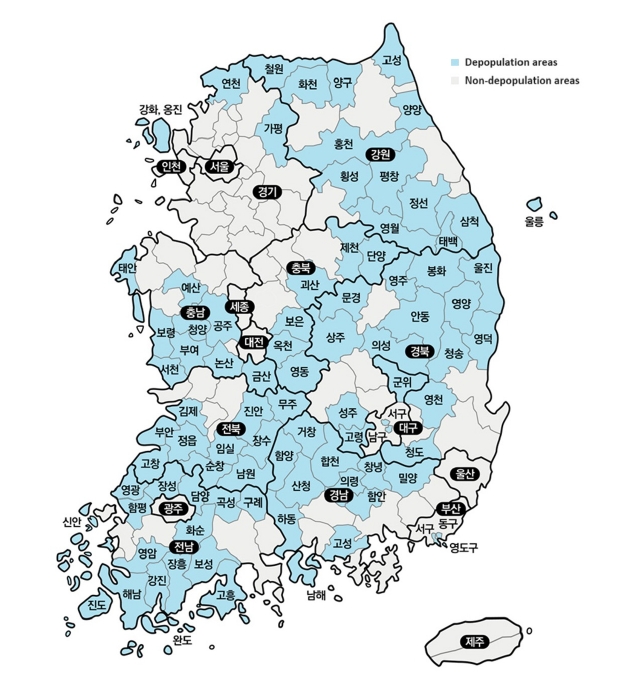
-
 Abstract
Abstract
 PDF
PDF - Objectives
The total population of Korea began to decline in 2019; in particular, the population in rural areas has been rapidly decreasing and is aging. Therefore, the government has designated depopulation areas and is seeking ways to support them. To assess whether health disparities exist between areas with population decline and those without, this study used community health survey data to observe temporal changes in health behaviors between the two types of areas. Methods: The analysis used Community Health Survey data from 2010 to 2019, and regional classification was divided by depopulation areas designated by the Ministry of the Interior and Safety. Trends in health behavior and chronic disease prevalence between depopulation and non-depopulation areas were analyzed. All analyses were conducted using complex sample analysis procedures in SAS 9.4 software. Results: The smoking rate steadily decreased in both depopulation and non-depopulation areas, whereas the high-risk drinking rate increased slightly. The walking practice rate did not improve in depopulation areas compared to non-depopulation areas. Furthermore, nutritional labeling usage rate was consistently lower in depopulation areas than in non-depopulation areas, with the gap being the largest. The prevalence of obesity, diabetes, and hypertension showed that the gap between depopulation and non-depopulation areas is continuously increasing. Conclusions: Health behaviors in depopulation areas have not improved, and the prevalence of chronic diseases is increasing rapidly. Therefore, the demand for health care services that support healthy lifestyle practices and chronic disease management in these areas is expected to increase.
- 2,112 View
- 23 Download

- [Korean]
- Analysis of the relationship between sugar intake and cancer prevalence: a cross-sectional study using the 8th Korea National Health and Nutrition Examination Survey
- Hye-Ryun Kim, Soo-Kyung Lee
- Korean J Community Nutr 2025;30(1):89-102. Published online February 28, 2025
- DOI: https://doi.org/10.5720/kjcn.2024.00339
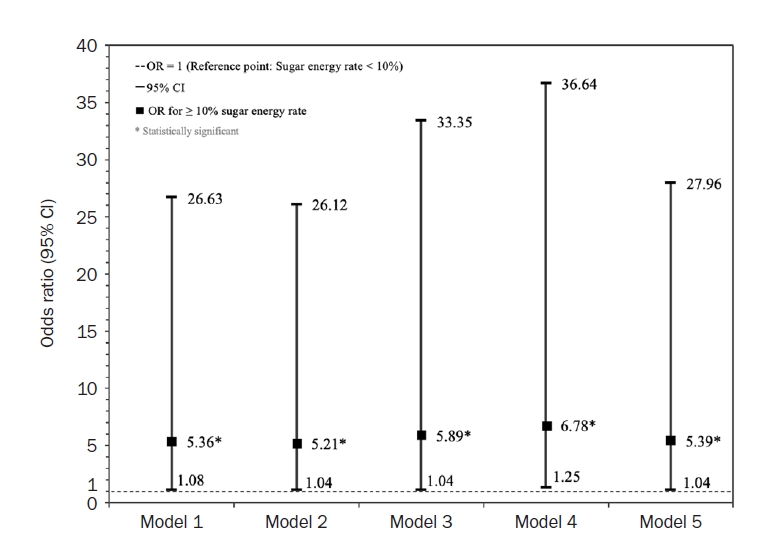
-
 Abstract
Abstract
 PDF
PDF Supplementary Material
Supplementary Material - Objectives
This study aimed to analyze the association between sugar intake and cancer risk among Korean adults aged 19 years and older.
Methods
A total of 13,016 adults aged 19 years and older who participated in the 8th Korea National Health and Nutrition Examination Survey from 2019 to 2021 were included. Sugar intake was assessed in terms of both absolute intake and sugar energy rate. Sugar intake was divided into quartiles, while sugar energy rate was categorized into three groups (< 10%, 10%–20%, > 20%) based on the 2020 Dietary Reference Intakes for Koreans and into two groups (< 10%, ≥ 10%) based on WHO recommendations. Cancer prevalence was determined using cancer-related survey questions. The association between sugar intake and cancer prevalence was analyzed by sex and cancer type using logistic regression. All statistical analyses were performed using IBM SPSS statistics 29.0 (IBM Co.).
Results
From 2019 to 2021, sugar intake significantly declined with age in both men and women (P for trend < 0.001), with the highest intake observed in the 19–29 age group (61.38 g). Men consumed significantly more sugar than women across all age groups except for the 50–64 and 65–74 groups (P < 0.05). However, the sugar energy rate was significantly higher in women than in men (P < 0.05). While the association between sugar intake and cancer prevalence varied across regression models and cancer types, cervical cancer consistently showed a significant association with sugar intake (P < 0.05).
Conclusion
The association between sugar energy rate and the prevalence of premenopausal cervical cancer was consistent and significant. Given that women had a higher sugar energy rate than men, the relationship between sugar intake and cancer prevalence in women warrants further investigation. Longitudinal studies with more detailed sugar intake assessments are needed. -
Citations
Citations to this article as recorded by- A study on hypertension relevant nutritional knowledge and dietary practices in Chinese college students studying in South Korea
Zhe Sun, Wookyoun Cho
Journal of Nutrition and Health.2015; 48(5): 441. CrossRef - Influence of the Size of the Spoon on the Eating rate, Energy Intake and the Satiety Levels of Female College Students
Yang Hee Hong, Young Suk Kim, Hyun Jung Kwon, Do Seok Chang, Dong Geon Kim, Un Jae Chang
Korean Journal of Community Nutrition.2015; 20(5): 375. CrossRef - Dietary behavior and nutritional status among Chinese female college students residing in Korea
Gaowei, Soyeon Kim, Namsoo Chang, Ki Nam Kim
Korean Journal of Nutrition.2013; 46(2): 177. CrossRef
- A study on hypertension relevant nutritional knowledge and dietary practices in Chinese college students studying in South Korea
- 2,297 View
- 86 Download
- 3 Crossref

- [English]
- Relationship between self-care and health-related behaviors among Korean adults: a cross-sectional study
- EunJung Lee, Jin A Jang, Ji-Myung Kim
- Korean J Community Nutr 2025;30(2):103-113. Published online April 29, 2025
- DOI: https://doi.org/10.5720/kjcn.2024.00255

-
 Abstract
Abstract
 PDF
PDF - Objectives
This study investigated the relationship between self-care and health-related behaviors such as medication use, dietary supplementation, dietary habits, and physical activity among Koreans aged 20–60 years.
Methods
Data from a total of 300 participants (150 men and 150 women) living in Seoul and Gyeonggi provinces in Korea were analyzed to assess the relationship between health behaviors and dietary supplements (DSs) related to self-care. Based on self-care levels, the participants were classified into three groups: low (LS, n = 124), medium (MS, n = 78), and high (HS, n = 98).
Results
DSs (P < 0.001), physical activity (P < 0.001), recognizing the perceived health benefits of self-care (P < 0.001), self-care when sick (P = 0.039), and the reasons for self-care (P = 0.028) differed among the self-care groups. Daily diet frequency (P = 0.001), breakfast frequency (P = 0.026), regular exercise (P < 0.001), DSs use rate (P < 0.001), DSs use frequency (P = 0.013), and total dietary behavior score (P < 0.001) also differed significantly depending on the degree of self-care. The degree of self-care was significantly and positively correlated with DSs intake (r = 0.377, P < 0.001), physical activity (r = 0.433, P < 0.001), and total dietary behavior score (r = 0.185, P < 0.01).
Conclusion
The results demonstrated that the degree of self-care was related to DSs, physical activity, and total dietary behavior scores in Korean adults. Additionally, self-care capacity should be increased through health-related behaviors based on health education programs.
- 1,633 View
- 55 Download

Review
- [English]
- Mercury exposure is associated with obesity: a systematic review and meta-analysis
- Jimin Jeon, Kyong Park
- Korean J Community Nutr 2023;28(3):192-205. Published online June 30, 2023
- DOI: https://doi.org/10.5720/kjcn.2023.28.3.192
-
 Abstract
Abstract
 PDF
PDF - Objectives
Previous studies have evaluated the association between mercury exposure and obesity but have yielded mixed conclusions. The aim of this study was to systematically review and summarize scientific evidence regarding the association between mercury exposure and obesity in the human population.
Methods
We conducted a systematic search of PubMed, Web of Science, Scopus, and Science Direct for articles related to mercury exposure and obesity. Meta-analyses of the highest and lowest categories of mercury levels were evaluated using a random effects model. Begg’s test was used to detect publication bias.
Results
A total of 9 articles were included. The pooled random effects odds ratio (OR) for mercury exposure and obesity of all 9 studies was 1.66 (95% confidence interval [CI]: 1.16-2.38). This positive association was evident in adults (OR: 1.61, 95% CI: 1.02-2.54) and among studies with Asian populations (OR: 2.00, 95% CI: 1.53-2.59), but not among those with North America/African populations (OR: 0.90, 95% CI: 0.50-1.65).
Conclusions
The present meta-analysis identified a positive association between mercury exposure and obesity. These findings suggest that toxic environmental metals such as mercury may be an important risk factor for obesity along with dietary habits and lifestyles. -
Citations
Citations to this article as recorded by- Re-thinking the link between exposure to mercury and blood pressure
Xue Feng Hu, Allison Loan, Hing Man Chan
Archives of Toxicology.2025; 99(2): 481. CrossRef - Associations of Metal Mixtures During Early Pregnancy With Midlife Obesity and Body Composition: A Prospective Study
Mingyu Zhang, Izzuddin M. Aris, Andres Cardenas, Sheryl L. Rifas‐Shiman, Pi‐I Debby Lin, Long H. Ngo, Emily Oken, Stephen P. Juraschek, Marie‐France Hivert
Obesity.2025; 33(10): 1984. CrossRef - Association Between Heavy Metals Exposure and Elevated High-Sensitivity C-Reactive Protein: Mediating Role of Body Mass Index
Seong-Uk Baek, Jin-Ha Yoon
Biomolecules.2025; 15(11): 1491. CrossRef - Association between heavy metal exposure and biomarkers for non-alcoholic fatty liver disease in Korean adolescents
Dong-Wook Lee, Jongmin Oh, Yu Min Lee, Hyun-Joo Bae, Youn-Hee Lim
Heliyon.2024; 10(19): e37840. CrossRef
- Re-thinking the link between exposure to mercury and blood pressure
- 2,386 View
- 66 Download
- 4 Crossref

Research Article
- [Korean]
- Dietary sodium and potassium intake of Koreans estimated using 2 different sources of their contents in foods, Food & Nutrient Database and the Korean Total Diet Study : a comparative study
- Jee Yeon Lee, Sung Ok Kwon, Soo Hyun Lee, Min Jeong Seo, Gae Ho Lee, Cho-il Kim
- Korean J Community Nutr 2023;28(3):235-244. Published online June 30, 2023
- DOI: https://doi.org/10.5720/kjcn.2023.28.3.235
-
 Abstract
Abstract
 PDF
PDF - Objectives
Based on the results from the Korean Total Diet Study (KTDS), the sodium (Na) and potassium (K) intake of Koreans were estimated and compared with intake estimates from the Food & Nutrient Database (FNDB), as in the Korea National Health and Nutrition Examination Survey (KNHANES) to verify the validity of these estimates.
Methods
One hundred and thirty-four representative foods (RFs) covering 92.5% of the total food intake of Koreans were selected, and 228 pairs of corresponding ‘RF x representative cooking method’ were derived by reflecting the methods used mainly in terms of frequency and quantity in their cooking. RF samples were collected from three cities with a larger population size in three regions (nine cities) nationwide, and six composite samples were made for each RF, considering its regional and/or seasonal characteristics. One thousand three hundred and sixty-eight ‘RF x representative cooking method’ pair samples were prepared, and the Na and K contents were assessed using inductively coupled plasma atomic emission spectrometry (ICP-MS). The Na and K intake of the Korean population was estimated by linking the content with the food intake data from the 7th KNHANES.
Results
The mean Na and K intake of Koreans were 2,807.4 mg and 2,335.0 mg per person per day, respectively. A comparison with the Na and K intake from KNHANES, including only RFs of KTDS, showed comparable results with less than 5% variation. While the contribution and ranking of food items to Na intake were similar between KNHANES and KTDS, there were differences in K intake. This was attributed to the large discrepancies in the K content of rice and coffee between KTDS results and the values in the 9th Revision of the National Food Composition Table used in KNHANES.
Conclusions
The Na and K intake of Koreans estimated based on the KTDS, which performed nutrient analysis on samples prepared to a ‘table-ready’ state using foods of the representative collection, was similar and comparable with that of KNHANES. This supports the validity and usefulness of FNDB-based nutrient intake estimation at the population level. The list of nutrients studied in KTDS is expected to be expanded, allowing for intake estimation of nutrients with currently insufficient or absent information in the FNDBs in use.
- 2,021 View
- 66 Download

Research Note
- [English]
- A pilot investigation of a combined food literacy and exercise program for college students: a one-group pre-post intervention study
- Minjeong Jeong, Jinhyun Kim, Dahye Han, Eunjin Jang, Kyoungho Choi, Sohyun Park
- Korean J Community Nutr 2024;29(6):455-466. Published online December 31, 2024
- DOI: https://doi.org/10.5720/kjcn.2024.00248
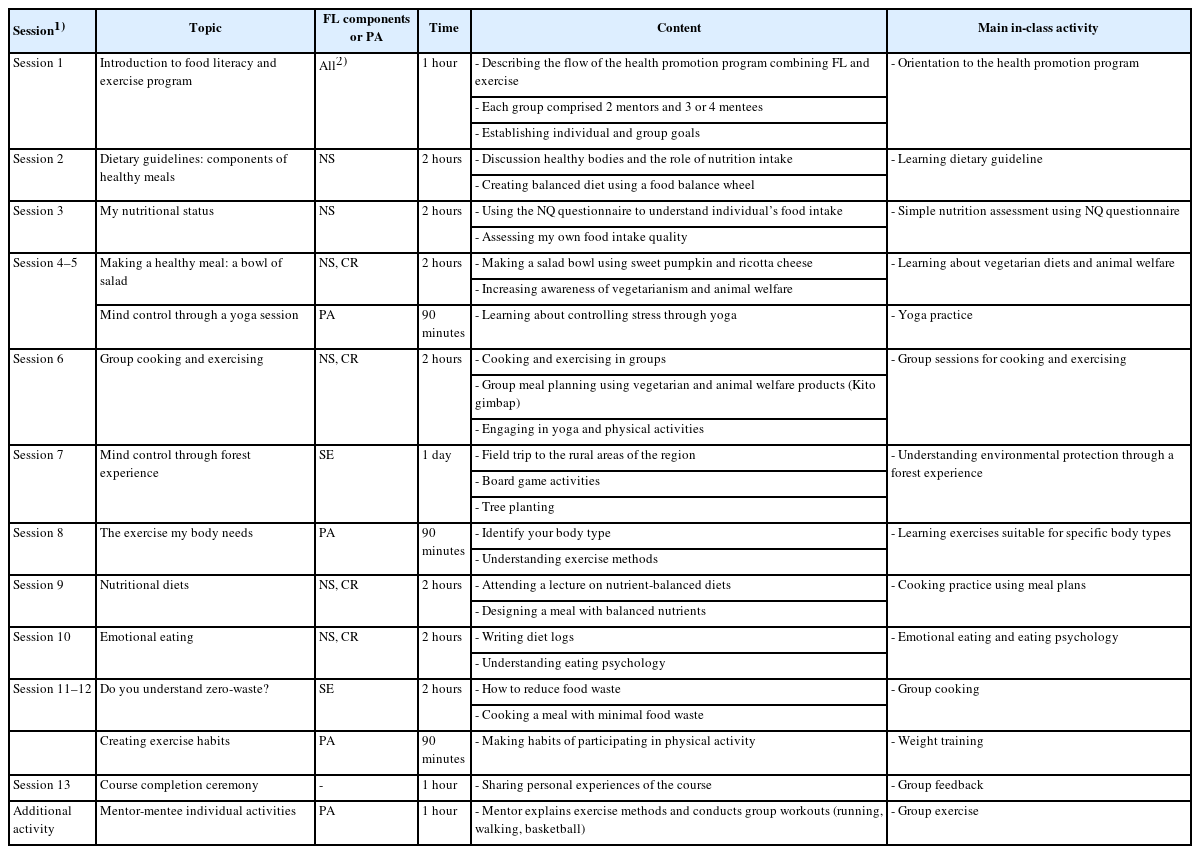
-
 Abstract
Abstract
 PDF
PDF - Objectives
A campus-based intervention to enhance food literacy (FL) and establish exercise habits among college students was developed and the program’s effectiveness was evaluated.
Methods
The 13-session program was developed based on the transtheoretical model and social cognitive theory. Junior and senior students majoring in food and nutrition and physical education were asked to participate as mentors, with freshmen and sophomores from varied majors as mentees. The program encompassed food, nutrition, and exercise lessons including cooking sessions. Data were collected via pre- and post-program surveys using a questionnaire consisting of items on FL and nutrition behaviors and physical fitness measurements.
Results
Among 39 participants (35.9% male, 64.1% female), the overall FL score increased significantly from 64.1 to 70.6 post-program (P = 0.001). Significant increases were observed in the nutrition and safety (P < 0.001), cultural and relational (P = 0.023), and socio-ecological (P = 0.001) domains, as well as knowledge (P = 0.001), self-efficacy (P = 0.013), attitude (P < 0.001), and behavior (P = 0.005) items in three domains of FL. Additionally, meal duration increased significantly (P = 0.007) and sit-up performance among female showed a meaningful change (P = 0.046). Changes in dietary behaviors significantly progressed (P = 0.015) while that in exercise habits approached a marginal significance (P = 0.053) after the intervention.
Conclusion
The results reveal positive changes in FL and some modifications in eating habits, although the program had limited effects on physical activity and fitness measurements. These findings suggest that strategic approaches to foster exercise behavior changes in college students are required. This pilot program can serve as foundational data for improving and expanding multicomponent health promotion programs for this population.
- 1,968 View
- 50 Download

Research Article
- [Korean]
- The needs and prioritization of nutrition and dietary support for individuals with disabilities: an exploratory study
- Jong Eun Park, Yu Jin Kim, So Young Kim, Jong Hyock Park
- Korean J Community Nutr 2024;29(5):431-443. Published online October 31, 2024
- DOI: https://doi.org/10.5720/kjcn.2024.00009
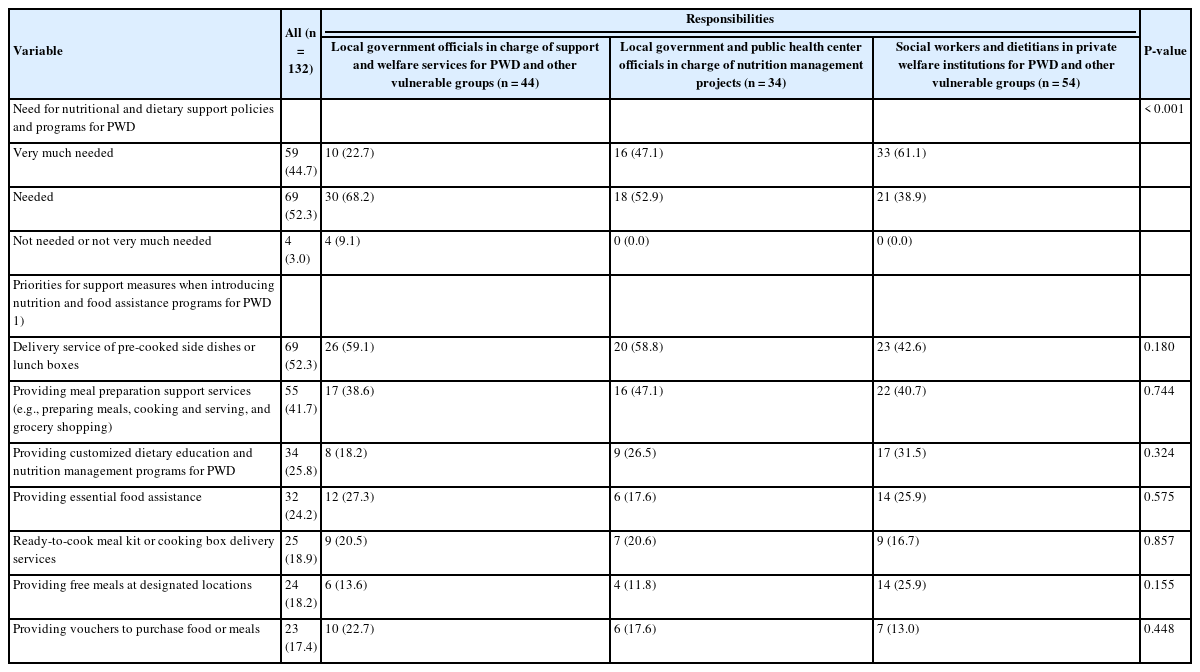
-
 Abstract
Abstract
 PDF
PDF - Objectives
Based on a survey of officers, social workers, and dietitians involved in managing nutrition and welfare policies or projects for vulnerable groups in local governments or private welfare institutions, this study aimed to assess the need for nutritional and dietary support policies and programs for persons with disabilities (PWD), as well as to identify appropriate support measures. Methods: An online survey was conducted from March 2 to 15, 2021. The survey included 20 questions exploring perspectives on the nutritional status of PWD, their need for nutritional and dietary support policies and programs, and the prioritization of appropriate support measures. A total of 132 responses were analyzed. Results: Approximately 68.9% of the respondents rated the nutritional status of PWD as “bad” or “very bad.” A substantial number identified “difficulty in purchasing ingredients, cooking, and preparing meals independently due to disability,” and “limited knowledge about nutrition and recipes necessary for maintaining a healthy and balanced diet” as the primary challenges in the dietary and nutritional management of this population. Additionally, 97.0% of the respondents deemed that the introduction of nutritional and dietary support policies and programs for PWD was “needed” or “very much needed.” Priority strategies to implement and strengthen these policies and systems included the “development of customized programs and services tailored to the needs and demands of the target population” and the “establishment of a dedicated department with specialized personnel.” Conclusion: Comprehensive nutritional and dietary support policies and programs should be actively implemented to ensure a healthy and stable diet for PWD, tailored to meet their actual needs and demands. -
Citations
Citations to this article as recorded by- Development of a standard nutrition management model algorithm for personalized care in social welfare facilities for the disabled
Su-Jin Lee, Ji-Won Kang, Sil Ah Kim, Kirang Kim, Sohyun Park, Jieun Oh, Hyunjoo Ryou, Ji-Yun Hwang
Journal of Nutrition and Health.2025; 58(5): 498. CrossRef - Factors associated with nutritional risk among disabled persons in the Republic of Korea: a cross-sectional study using 2020 Disability and Life Dynamics Panel
Seong-Ah Kim, Seul Ki Choi
Korean Journal of Community Nutrition.2025; 30(5): 364. CrossRef
- Development of a standard nutrition management model algorithm for personalized care in social welfare facilities for the disabled
- 2,167 View
- 104 Download
- 2 Crossref

Educational Materials
- [English]
- Development of a campus-based intervention program to strengthen food literacy among university students: A qualitative formative study
- Eunji Ko, Eunjin Jang, Jiwon Sim, Minjeong Jeong, Sohyun Park
- Korean J Community Nutr 2023;28(6):495-508. Published online December 31, 2023
- DOI: https://doi.org/10.5720/kjcn.2023.28.6.495
-
 Abstract
Abstract
 PDF
PDF - Objectives
This study aimed to develop a campus-based intervention program to enhance food literacy (FL) among university students.
Methods
In the initial phase, we conducted a literature review of FL intervention studies and held in-depth interviews with university students to identify facilitators and barriers to improving and practicing FL. Expert counseling sessions were conducted with nutrition education, marketing, and service design professionals. The results of this phase led to the creation of an initial curriculum draft. In the second phase, a follow-up survey was conducted with young adults to assess the acceptability of the developed curriculum. After the follow-up survey, additional meetings were conducted with the aforementioned experts, and the curriculum was further refined based on their input.
Results
An 11-week FL intervention program was devised using constructs from the Social Cognitive Theory. The weekly curriculum consisted of 90-min theory-based and 90-min hands-on experience sessions. Three primary aspects of FL were covered: nutrition and food safety, cultural and relational dimensions, and socio-ecological aspects. Program highlights included cooking sessions for crafting traditional Korean desserts, lectures on animal welfare, insights into zero-waste practices, and communal eating experiences. Based on the study team’s previous research, the program also addressed mindful eating, helping participants understand the relationship with their eating habits, and providing strategies to manage negative emotions without resorting to food. Yoga sessions and local farm visits were incorporated into the curriculum to promote holistic well-being.
Conclusions
This study elucidated the comprehensive process of creating a campus-based curriculum to enhance FL among university students, a group particularly susceptible to problematic eating behaviors and low FL levels. The developed program can serve as a blueprint for adaptation to other campuses seeking to bolster students’ FL. -
Citations
Citations to this article as recorded by- Effects of nutrition class with cooking lab on college students’ eating behaviors and well-being in the United States: a mixed-methods study
Borham Yoon, Kyungyul Jun
Nutrition Research and Practice.2025; 19(2): 305. CrossRef - Evaluating the effectiveness of a food literacy pilot program for university students: using a mixed-methods research approach
Eunji Ko, Eunjin Jang, Jiwon Sim, Minjeong Jeong, Sohyun Park
Nutrition Research and Practice.2024; 18(6): 885. CrossRef - A pilot investigation of a combined food literacy and exercise program for college students: a one-group pre-post intervention study
Minjeong Jeong, Jinhyun Kim, Dahye Han, Eunjin Jang, Kyoungho Choi, Sohyun Park
Korean Journal of Community Nutrition.2024; 29(6): 455. CrossRef
- Effects of nutrition class with cooking lab on college students’ eating behaviors and well-being in the United States: a mixed-methods study
- 2,015 View
- 59 Download
- 3 Crossref

Research Articles
- [English]
- Shifting social perceptions of dietitians in Korea after the legislation of nutrition teachers: a keyword network analysis of unstructured data
- Yunkyoung Oh, Eunsil Her
- Korean J Community Nutr 2025;30(3):214-223. Published online June 30, 2025
- DOI: https://doi.org/10.5720/kjcn.2025.00045
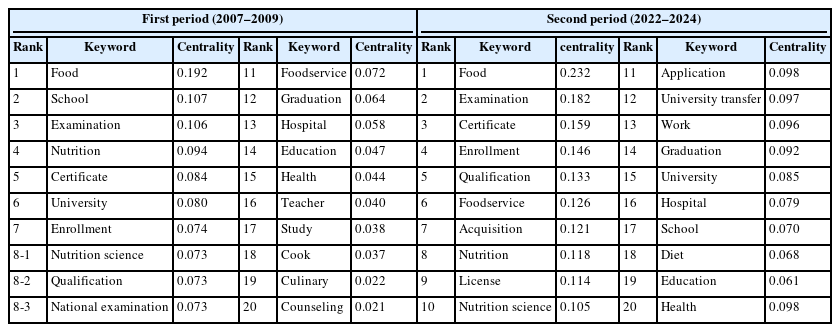
-
 Abstract
Abstract
 PDF
PDF - Objectives
In Korea, dietitian licenses began to be issued in 1964, and they have been working to prevent diseases and promote people’s health in various fields according to the times. This study was conducted to compare differences in social perception of dietitian over time by collecting online unstructured data and analyzing the frequency and network structure of nutritionist-related keywords after the deployment of nutrition teachers began.
Methods
Using ‘dietitian’ as a keyword, we collected data from NAVER’s web, blogs, and news provided by Textom (2024, The IMC) and refined the data. We investigated the frequency ranking of keywords related to dietitians for each period, revealed the network structure using UCINET6 (Freeman) and Netdraw, and clustered similar concepts among keywords through CONCOR (CONvergence of iterated CORrelations) analysis to cluster-related concepts.
Results
Frequency analysis revealed that during the first period, keywords such as “School” and “Education” reflecting the institutionalization of nutrition teachers, were highly ranked. However, by the second period, these terms had dropped out of the top 10. Meanwhile, keywords related to healthcare, such as “Hospital”, consistently remained among the most prominent. In the second period, the rankings of the “License” and “University transfer” keywords increased significantly. Centrality analysis showed stronger connectivity between dietitians and keywords such as “Food”, “School”, “Examination”, and “Nutrition” in the second period compared to the first. CONCOR analysis further demonstrated that the “Major education” cluster of the first period was differentiated into the “Major education and qualification” and “professional competency certification process” clusters of the second period. In addition, the “Health and welfare” cluster of the first period was divided into the “Health and welfare regional service” clusters of the second period.
Conclusion
The results of this study will be used as basic data for identifying social perception and trends in the dietitian profession, further providing a scope for their improvement.
- 1,582 View
- 17 Download

- [English]
- Sex differences in health-related quality of life among older Korean adults with type 2 diabetes mellitus: a cross-sectional study
- Hyeonji Jeong, Kyong Park
- Korean J Community Nutr 2024;29(4):336-347. Published online August 31, 2024
- DOI: https://doi.org/10.5720/kjcn.2024.00003
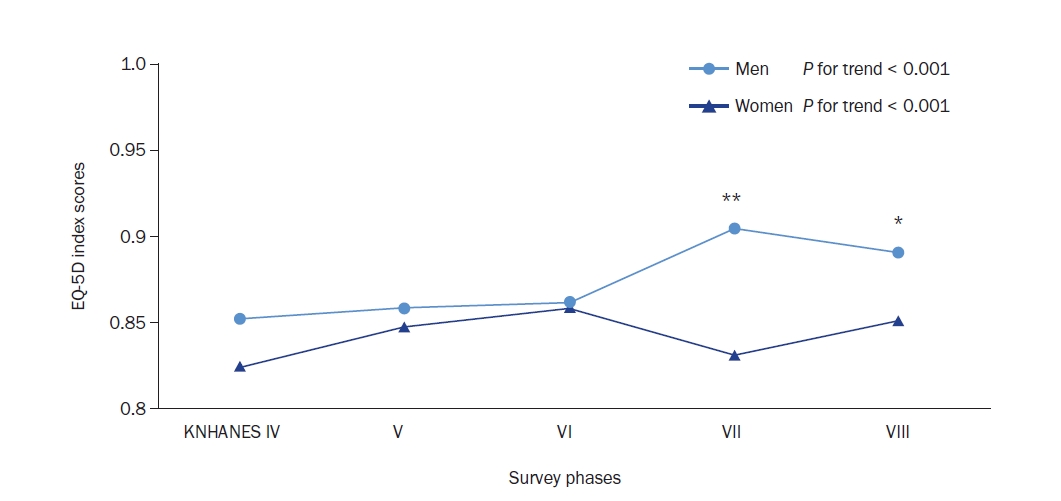
-
 Abstract
Abstract
 PDF
PDF - Objectives
This cross-sectional study examined sex differences in Health-Related Quality of Life (HRQoL) among seniors with Type 2 Diabetes Mellitus (T2DM).
Methods
Data from the Korea National Health and Nutrition Examination Survey (2008–2020) were analyzed. The EuroQol-5 Dimensions (EQ-5D), a measure of HRQoL, was used. It comprises five dimensions: mobility, self-care, usual activity, pain/discomfort, and anxiety/depression, each with three levels.
Results
Analysis of 3,826 older adults with T2DM showed a significant increasing trend in the EQ-5D Index from the 4th survey phase onwards (P for trend < 0.001 for both men and women). Men consistently reported higher EQ-5D levels than women across all survey years. Women’s EQ-5D levels remained lower than men’s, maintaining a decade-old disparity (P < 0.05). Men scored significantly higher (P < 0.05) in most EQ-5D domains, except for self-care and anxiety/depression, resulting in a higher total EQ-5D Index (P = 0.001). Increased comorbidities were strongly associated with lower EQ-5D levels in both sexes. Additionally, there was a negative correlation between the EQ-5D Index and refined grain intake for both sexes (P for trend < 0.001), with high-EQ-5D groups consuming fewer refined grains. Women in the high-EQ-5D group consumed more nuts, vegetables, and meat compared to men (P for trend < 0.05).
Conclusions
Our study highlights the sex disparities in HRQoL among older adults with T2DM. The findings suggest the need for tailored treatment guidelines aimed at improving the HRQoL of elderly T2DM patients, with a focus on their sex-specific characteristics. Implementing these tailored guidelines could enhance the HRQoL of older women with T2DM and promote more equitable healthcare outcomes. This underscores the importance of considering sex differences to comprehensively improve the well-being of this population. -
Citations
Citations to this article as recorded by- Understanding Gender Disparities in Quality of Life Among Patients With Type 2 Diabetes in Ethiopia: An Institutional‐Based Study
Enguday Demeke Gebeyaw, Girma Deshimo Lema
Lifestyle Medicine.2025;[Epub] CrossRef
- Understanding Gender Disparities in Quality of Life Among Patients With Type 2 Diabetes in Ethiopia: An Institutional‐Based Study
- 2,161 View
- 39 Download
- 1 Crossref

- [English]
- The impact of flash continuous glucose monitoring and nutrition coaching on dietary self-efficacy and weight management in university students in Korea: a pre-post intervention study
- Soojin Park
- Korean J Community Nutr 2025;30(3):183-196. Published online June 30, 2025
- DOI: https://doi.org/10.5720/kjcn.2025.00073
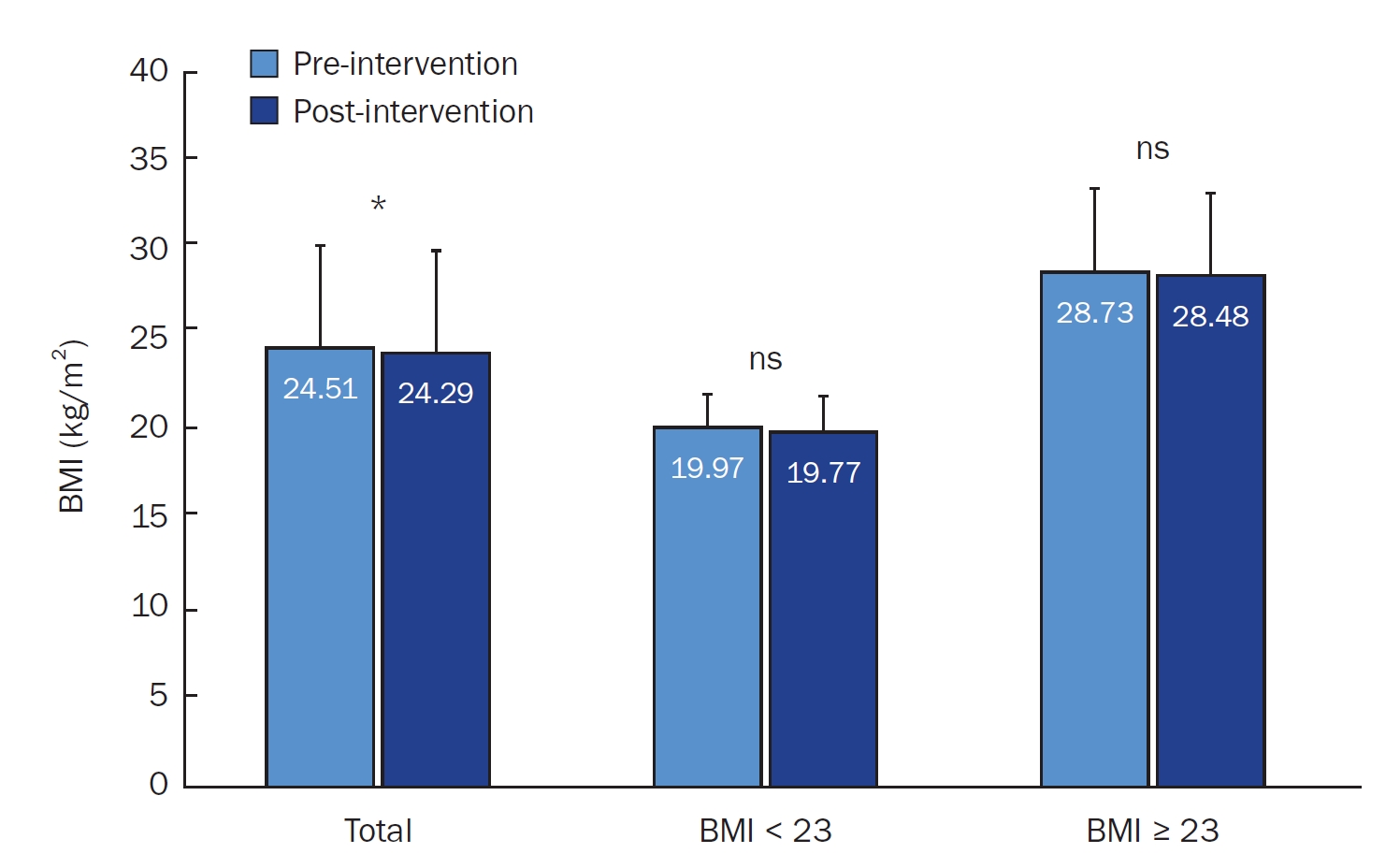
-
 Abstract
Abstract
 PDF
PDF - Objectives
This study aimed to evaluate the impact of a 4-week multicomponent intervention combining flash continuous glucose monitoring (flash-CGM), group nutrition education, and personalized nutrition coaching on dietary self-efficacy (DSE) and weight management in healthy university students.
Methods
A total of 27 university students participated in a pre-post intervention study. The intervention included a single 4-hour group-based nutrition education session, flash-CGM usage (FreeStyle Libre; Abbott Diabetes Care), and weekly one-on-one nutrition coaching. Participants wore the CGM device for 28 days (replaced after 14 days), and were guided in using the FoodLens app (DoingLab) for dietary tracking and a mobile app-linked digital scale for weight monitoring. Outcomes measured before and after the intervention included DSE, body mass index (BMI), nutrition quotient (NQ) and glycemic indicators. Statistical analyses included Wilcoxon signed-rank and Mann-Whitney U-tests with significance set at P < 0.05.
Results
There was a significant increase in DSE (P < 0.05), particularly in managing eating behavior under stress and fatigue. A modest but significant decrease in BMI was observed in the overall group (P < 0.05), though changes were not significant in the BMI ≥ 23 kg/m2 subgroup. Glycemic indicators showed minimal changes. The overall NQ score improved slightly, with significant increases in fruit intake (P < 0.01) and nutrition label checks (P < 0.05). High satisfaction levels (4.52 ± 0.65 on a 5‑point scale) were reported for device usability and coaching services.
Conclusion
The multicomponent intervention improved DSE, NQ scores, and supported modest weight reduction among university students. The combined effect of CGM, nutrition education, and coaching appears promising; however, further studies are needed to isolate the effects of each component and evaluate long-term outcomes. Trial Registration: Clinical Research Information Service Identifier: KCT0010255.
- 1,414 View
- 24 Download

- [Korean]
- Impact of a public health center nutrition education program on patients with type 2 diabetes in a primary care-based chronic disease management project: a pilot intervention study
- Haerim Yang, Yoo Kyoung Park, Ji-hyun Lee, Hee-Sook Lim, Heejoon Baek, Hyejin Lee, Haeran Park, Pyunghwa Lee, Jooyoun Chung, Won Gyoung Kim
- Korean J Community Nutr 2024;29(6):492-503. Published online December 31, 2024
- DOI: https://doi.org/10.5720/kjcn.2024.00018
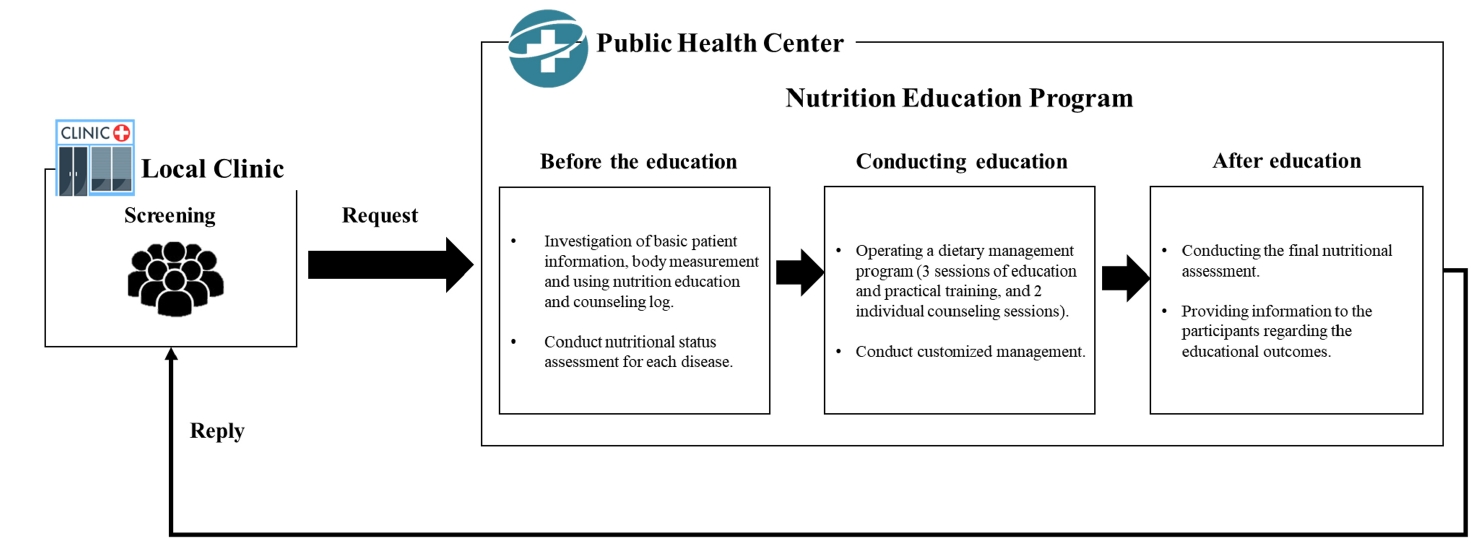
-
 Abstract
Abstract
 PDF
PDF - Objectives
We investigated the impact of an advanced “Nutrition Education Program” on patients with Diabetes mellitus, type 2 from public health centers enrolled in a primary health care-based chronic disease management project. This 12-week dietary management program was developed by the Korea Health Promotion and Development Institute. We assessed if this program improved glycemic control and other health indicators through dietary and nutritional improvements.
Methods
Seventeen patients with Diabetes mellitus type 2 were enrolled in the “Nutrition Education Program.” These patients were referred to public health centers for lifestyle management based on physician assessments at local clinics that were participating in a pilot project on primary health care-based chronic disease management. The participants attended the program comprising face-to-face basic, in-depth, and practical training sessions at the health center during the third, fifth, and seventh weeks, respectively. Anthropometric measurements, body composition analysis, blood biochemical characteristics, nutritional knowledge, and self-efficacy evaluation were performed before and after the program. Data were analyzed using SPSS ver. 28.0.
Results
The mean age of the participants was 62 years, and most participants were female (14, 82.4%). No significant changes in patients’ anthropometric measurements or body composition were observed after the training. However, significant reductions were observed in the blood biochemical characteristics, including glycated hemoglobin, total cholesterol, and low-density lipoprotein levels. Additionally, patients’ nutritional knowledge and self-efficacy scores increased significantly.
Conclusions
The “Nutrition Education Program” helped in improving glycemic control and other health indicators in patients with Diabetes mellitus type 2. Further research is required to objectively confirm the long-term and sustained effects of the program in a controlled study. Trial Registration Clinical Research Information Service Identifier: KCT0010010
- 1,935 View
- 78 Download

- [Korean]
- Development and applicability evaluation of a nutrition education program for residents and users of disability social welfare facilities in Korea: a mixed-methods study
- Jin-kyung Kim, Kyoung-min Lee, Min-sun Jeon
- Korean J Community Nutr 2025;30(1):64-74. Published online February 28, 2025
- DOI: https://doi.org/10.5720/kjcn.2025.00017
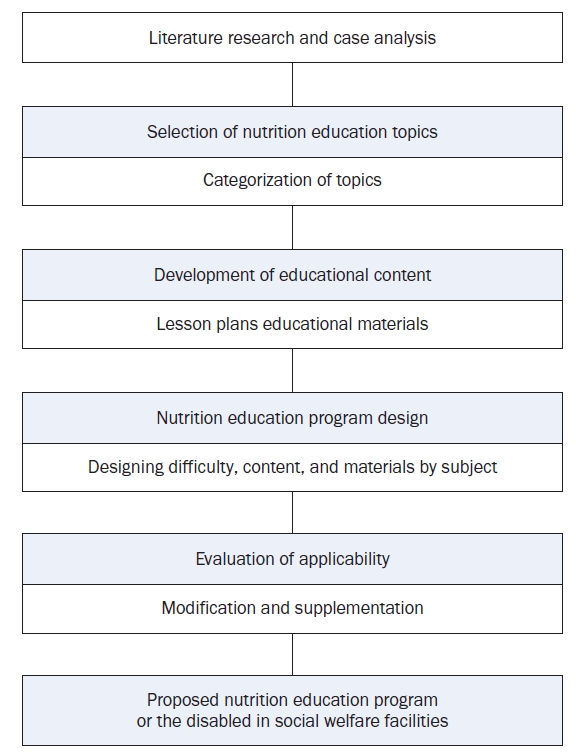
-
 Abstract
Abstract
 PDF
PDF - Objectives
This study aimed to develop a nutrition education program based on social cognitive theory to promote the health of individuals using facilities for people with disabilities. It also sought to evaluate the applicability of the educational materials through assessments by counselors at the Social Welfare Food Service Management Support Center.
Methods
A group of six experts developed the program based on a needs assessment of nutrition education in facilities for individuals with disabilities. Applicability was evaluated through an online survey of 26 counselors from Social Welfare Food Service Management Support Centers nationwide in July 2023, and the results were analyzed.
Results
The nutrition education program includes a basic course on personal hygiene, dining etiquette, picky eating prevention, and obesity management. The advanced course covers dietary management for chronic diseases, such as meal planning for hypertension, diabetes management, and dietary principles for dysphagia. Additionally, lecture PPTs, individual activity sheets, and experiential teaching aids were developed. Applicability evaluations showed high scores, with the teaching-learning plan and PPT averaging 4.15 and the experiential teaching aids scoring 4.17, all above 4.0.
Conclusion
This study developed a nutrition education program for individuals with disabilities and assessed its applicability and usability. Implementing this program in disability welfare institutions could enhance health promotion and improve the quality of life for individuals with disabilities. -
Citations
Citations to this article as recorded by- Development of a standard nutrition management model algorithm for personalized care in social welfare facilities for the disabled
Su-Jin Lee, Ji-Won Kang, Sil Ah Kim, Kirang Kim, Sohyun Park, Jieun Oh, Hyunjoo Ryou, Ji-Yun Hwang
Journal of Nutrition and Health.2025; 58(5): 498. CrossRef
- Development of a standard nutrition management model algorithm for personalized care in social welfare facilities for the disabled
- 2,088 View
- 72 Download
- 1 Crossref

- [English]
- Nutrition education programs necessary for social welfare facilities for persons with disabilities: a cross-sectional study
- Jinkyung Kim, Min-Sun Jeon
- Korean J Community Nutr 2024;29(1):1-15. Published online February 29, 2024
- DOI: https://doi.org/10.5720/kjcn.2024.29.1.1
-
 Abstract
Abstract
 PDF
PDF - Objectives
This study investigated the need for nutrition education aimed at improving the health of residents and users of social welfare facilities for persons with disability and aimed to provide basic information for developing a nutrition education program that meets the needs of the field.
Methods
Altogether, 249 employees working in social welfare facilities for people with disabilities were included in the study. Data on the health status of residents/users, meal management, nutritional education, nutritional education needs, and awareness of nutritional education were obtained through online surveys. A descriptive analysis was conducted to analyze the demographic characteristics, needs, and perceptions of the respondents, and independent t-tests and χ2 tests were performed to analyze and compare the differences between residential and daycare facilities.
Results
The majority of residents/users of social welfare facilities for persons with disabilities have developmental disabilities. When educating residents with residents/users of social welfare facilities, ‘personal hygiene’ was the most necessary topic, followed by ‘obesity management’ education. Regarding the methods of providing education, face-to-face lectures demonstrated a high demand. They responded that when nutrition education experts provide nutrition education to people with disabilities, they must understand ‘the physical characteristics of persons with disabilities’ and have the ability to determine appropriate nutrition for such people. The most appropriate nutrition program training would be twice a year, lasting 30 min to 1 h per training session.
Conclusions
It will present a direction for operating a nutrition education program for persons with disabilities that meets their needs of social welfare facilities and ultimately contribute to the establishment and activation of nutrition education tailored to welfare facilities for such individuals in Korea. -
Citations
Citations to this article as recorded by- Development and applicability evaluation of a nutrition education program for residents and users of disability social welfare facilities in Korea: a mixed-methods study
Jin-kyung Kim, Kyoung-min Lee, Min-sun Jeon
Korean Journal of Community Nutrition.2025; 30(1): 64. CrossRef
- Development and applicability evaluation of a nutrition education program for residents and users of disability social welfare facilities in Korea: a mixed-methods study
- 1,554 View
- 40 Download
- 1 Crossref

Review
- [English]
- Research trends relating to body weight control: a systematic review and keyword network analysis of Korea Citation Index Journals (2004–2023)
- Yunkyoung Oh, Eunsil Her
- Korean J Community Nutr 2024;29(6):445-454. Published online December 31, 2024
- DOI: https://doi.org/10.5720/kjcn.2024.00269
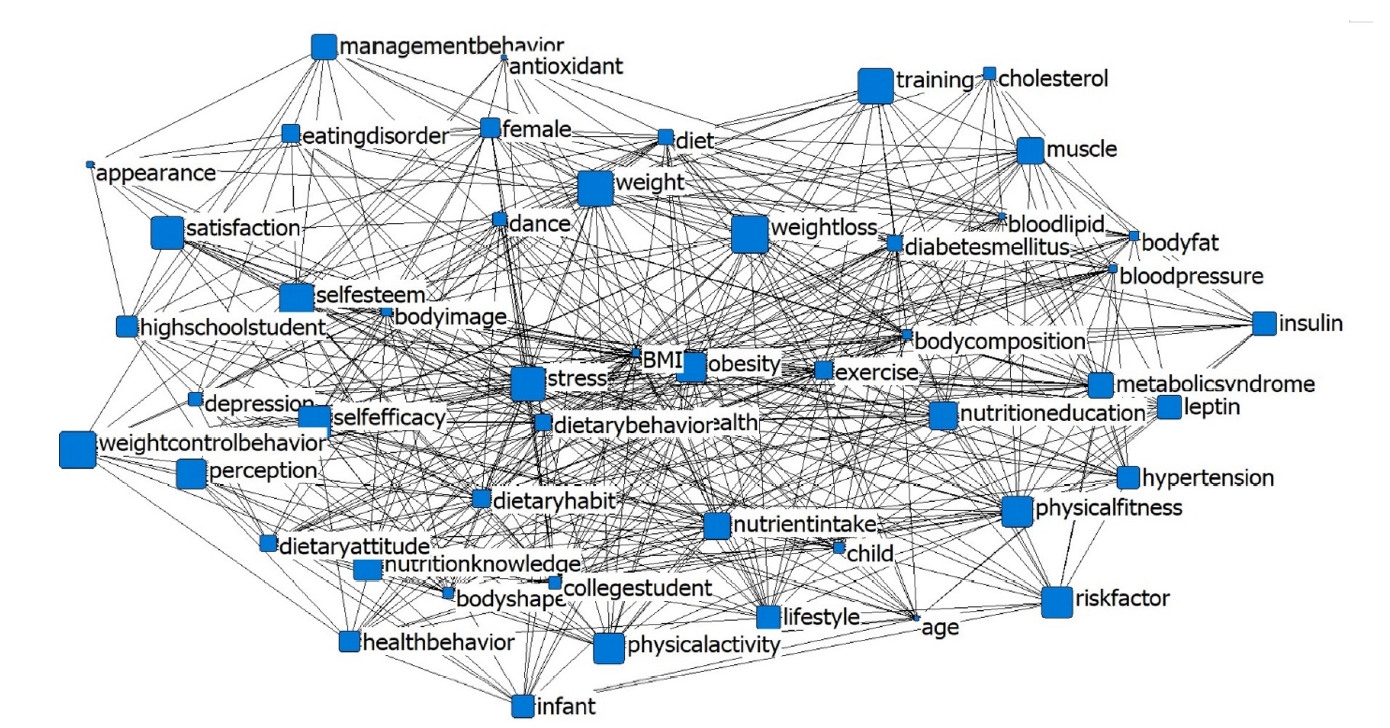
-
 Abstract
Abstract
 PDF
PDF - Objectives
Obesity rates are rapidly rising in Korea. Weight control is highly involved in obesity treatment. This study aimed to explore research trends related to weight control through keyword network analysis. By focusing on journals indexed in the Korea Citation Index (KCI), this study highlights trends specific to Korea, offering insights that reflect the country’s unique cultural and policy contexts in weight control research.
Methods
This study collected keywords from weight control-related papers published in the KCI journal over the past 20 years. Keywords were cleaned through Textom (2024), and the relationships between key research issue frequency analysis, structural characteristics, and keywords were identified using Textom, UCINET6, and NetDraw.
Results
Over the past 20 years, 40 to 50 studies related to weight control have been conducted each year. The Korean Journal of Community Nutrition had the largest number of published articles. Keyword frequency analysis showed that ‘obesity’ had the highest frequency. And the analysis of degree centrality and betweenness centrality, the keyword ‘obesity’ ranked the highest. CONCOR analysis identified four clusters: preventive health care, health management, physical health, and personal development.
Conclusion
The results of this study showed that weight control research reflecting the characteristics of the times has been steadily progressing in relation to the rapidly increasing obesity in Korea, and when developing policies or setting research directions related to weight loss in the future, research should be conducted in a prospective manner by subdividing it according to groups and interests.
- 1,925 View
- 38 Download

Research Articles
- [Korean]
- Estimating and evaluating usual total fat and fatty acid intake in the Korean population using data from the 2019–2021 Korea National Health and Nutrition Examination Surveys: a cross-sectional study
- Gyeong-yoon Lee, Dong Woo Kim
- Korean J Community Nutr 2023;28(5):414-422. Published online October 31, 2023
- DOI: https://doi.org/10.5720/kjcn.2023.28.5.414
-
 Abstract
Abstract
 PDF
PDF - Objectives
This study evaluated usual dietary intakes of total fat and fatty acids among the Korean population based on the revised Dietary Reference Intakes for Koreans 2020 (2020 KDRIs).
Methods
This study utilized data from the eighth Korea National Health and Nutrition Examination Survey (KNHANES 2019–2021). We included 18,895 individuals aged 1 year and above whose 1-day 24-hour dietary recall data were available. To calculate the external variability using the National Cancer Institute 1-day method, data from the U.S. NHANES 2017-March 2020 Pre-pandemic dataset were employed. The total fat and fatty acid intake were evaluated based on the Acceptable Macronutrient Distribution Ranges (AMDRs) and Adequate intake (AI) of 2020 KDRIs for each sex and age groups.
Results
Approximately 86% of the Korean population obtained an adequate amount of energy from total fat consumption (within the AMDRs), indicating an appropriate level of intake. However, the percentage of individuals consuming saturated fatty acids below the AMDR was low, with only 12% among those under 19 years of age and 52% aged 19 years and older. On a positive note, approximately 70% of the population showed adequate consumption of essential fatty acids, exceeding the AI. Nevertheless, monitoring the intake ratio of omega 3 (n-3) to omega 6 (n-6) fatty acids is essential to ensure an optimum balance.
Conclusions
This study explored the possibility of estimating the distribution of nutrient intake in a population by applying the external variability ratio. Therefore, if future KNHANES conduct multiple 24-hour recalls every few years-similar to the U.S. NHANES-even for a subset of participants, this may aid in the accurate assessment of the nutritional status of the population. -
Citations
Citations to this article as recorded by- Nutritional risk assessment using estimated usual nutrient intake in Korean adults: analysis of the 8th (2019–2021) Korea National Health and Nutrition Examination Survey data
Woojin Byeon, Cho-il Kim, Sung Ok Kwon, Jihyun Yoon, Linxi Huang
Nutrition Research and Practice.2025; 19(5): 799. CrossRef - The association between COVID-19 and changes in food consumption in Korea: analyzing the microdata of household income and expenditure from Statistics Korea 2019–2022
Haram Eom, Kyounghee Kim, Seonghwan Cho, Junghoon Moon
Journal of Nutrition and Health.2024; 57(1): 153. CrossRef - Dietary intake and food sources of essential fatty acids among Korean adolescents: a cross-sectional study based on the 2016–2021 KNHANES data
Enkhgerel Erdenetsetseg, Hye Ran Shin, SuJin Song
Korean Journal of Community Nutrition.2024; 29(2): 144. CrossRef
- Nutritional risk assessment using estimated usual nutrient intake in Korean adults: analysis of the 8th (2019–2021) Korea National Health and Nutrition Examination Survey data
- 2,242 View
- 44 Download
- 3 Crossref

- [English]
- Comparison of clinical characteristics and dietary intakes according to phenotypes of type 2 diabetes mellitus in South Korea: a cross-sectional study
- Mi-Jin Kim, Ji-Sook Park, Sung-Rae Cho, Daeung Yu, Jung-Eun Yim
- Korean J Community Nutr 2025;30(2):127-139. Published online April 29, 2025
- DOI: https://doi.org/10.5720/kjcn.2025.00059

-
 Abstract
Abstract
 PDF
PDF - Objectives
Clinical nutrition treatment is the central part of diabetes management, such as prevention, treatment, and self-management of diabetes, and personalized clinical nutrition treatment, which enables improvement in patients with type 2 diabetes mellitus (T2DM). Our study aimed to contribute to the improvement of appropriate nutrition management in personalized treatment for obese and non-obese diabetes patients.
Methods
T2DM patients were recruited as participants, and 36 final participants were assigned to the lean diabetes mellitus group (LDM; body mass index [BMI] < 25 kg/m2) and the obese diabetes mellitus group (ODM; BMI ≥ 25 kg/m2). We assessed the dietary intakes, body composition, dietary habits, the Korean version of obesity-related quality of life, and biochemical indices.
Results
According to the phenotype’s comparison, the ODM group had a high prevalence of T2DM complications and hypertension, had a dietary habit of less than 10 minutes of mealtime duration and preferred fast food intake, and had a low obesity-related quality of life. However, the LDM group had a high choice of Korean dishes at the time of eating out and a high intake of vitamin C, and iodine because of the intake of vegetables and seaweeds.
Conclusion
We observed differences in diet, nutrient intake, and clinical characteristics according to the phenotype of T2DM patients. In particular, obese diabetes patients have an increased risk of cardiovascular diseases, bad dietary habits, and low obesity-related quality of life. Therefore, personalized nutrition treatment is needed in consideration of the risk of cardiovascular disease and dietary habits for patients in the ODM group, as well as determining the energy requirements of Korean patients with T2DM.
- 1,453 View
- 31 Download


 KSCN
KSCN

 First
First Prev
Prev



